This form dynamically changes the labels for the Surname and Forename field based on the value of the Gender field. Wut?
Because a Male Surname is totally distinct and nothing like a Female Surname, I guess?!?
This form dynamically changes the labels for the Surname and Forename field based on the value of the Gender field. Wut?
Because a Male Surname is totally distinct and nothing like a Female Surname, I guess?!?
I nerdsniped myself today when, during a discussion on the potential location of a taekwondo tournament organised by our local martial arts school, somebody claimed that Scotland would be “nearer” than Ireland.

But the question got me thinking:
Could I plot a line across Great Britain, showing which parts are closer to Scotland and which parts are closer to Ireland?
If the England-facing Irish and Scottish borders were completely straight, one could simply extend the borders until they meet, bisect the angle, and we’d be done.

In reality, the border between England and Scotland is a winding mess, shaped by 700 years of wars and treaties1. Treating the borders as straight lines is hopelessly naive.
What I’m really looking for… is a Voronoi partition…

My Python skills are pretty shit, but it’s the best tool for the job for geohacking2. And so, through a combination of hacking, tweaking, and crying, I was able to throw together a script that produces a wonderful slightly-wiggly line up the country.
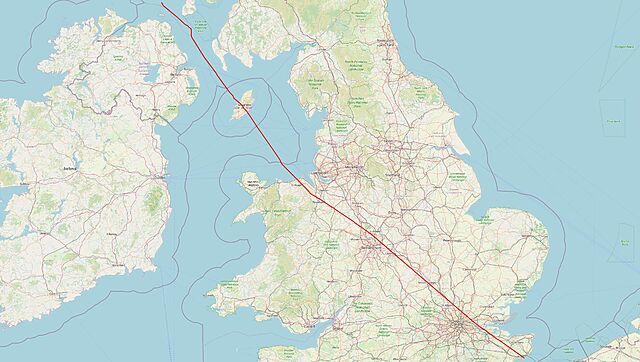
Once you’ve bisected England in this way – into parts that are “closer to Ireland” versus parts that are “closer to Scotland”, you start to spot all kinds of interesting things3.
Like: did you know that the entire subterranean part of the Channel Tunnel is closer to Scotland than it is to Ireland… except for the ~2km closest to the UK exit.
A little further North: London’s six international airports are split evenly across the line, with Luton, Stansted and Southend closer to Scotland… and City, Heathrow and Gatwick closer to Ireland.
The line then pretty-much bisects Milton Keynes, leaving half its population closer to Scotland and half closer to Ireland, before doing the same to Daventry, before – near Sutton Coldfield – it drives right through the middle of the ninth hole of the golf course at the Lea Marston Hotel.
Players tee off closer to Ireland and – unless they really slice it – their ball lands closer to Scotland:
In Cannock, it bisects the cemetery, dividing the graves into those on the Scottish half and those in the Irish half:
The line crosses the Welsh border at the River Dee, East of Wrexham, leaving a narrow sliver of Wales that’s technically closer to Scotland than it is to Ireland, running up the coastline from Connah’s Quay to Prestatyn and going as far inland as Mold before – as is the case in most of Wales – you’re once again closer to Ireland:
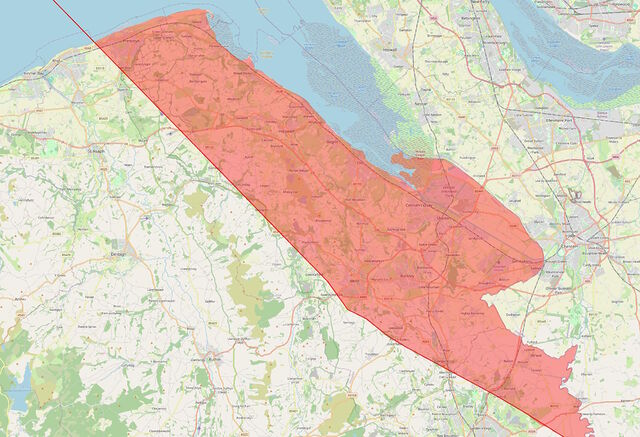
I’d never have guessed that there were any parts of Wales that were closer to Scotland than they were to Ireland, but the map doesn’t lie4
Anyway: that’s how I got distracted, today. And along the way I learned a lot about geodata encoding, a little about Python, and a couple of surprising things about geography5.
1 Not to mention the crazy history of places like Berwick-upon-Tweed, which has jumped the border several times, and Ba Green, ownership of which has traditionally been decided by game of football.
2 Or, at least: it’s the one that’s most-widely used and so I could find lots of helpful StackOverflow answers when I got stuck!
3 Interesting… if you’re specifically looking for some geographical trivia, that is!
4 Okay, the map lies a little. My program was only simple so it plotted everything on a flat plane, failing to accommodate for Earth’s curvature. The difference is probably marginal, but if you happen to live on or very close to the red line, you might need to do your own research!
5 Like: Chester and Rugby are closer to Scotland than they are to Ireland, and Harpenden and Towcester are closer to Ireland than they are to Scotland! Who knew?
This post is also available as a podcast. Listen here, download for later, or subscribe wherever you consume podcasts.
Sometimes I’ve seen signs on dual carriageways and motorways that seem to specify a speed limit that’s the same as the national speed limit (i.e. 60 or 70 mph for most vehicles, depending on the type of road), which seem a bit… pointless? Today I learned why they’re there, and figured I’d share with you!
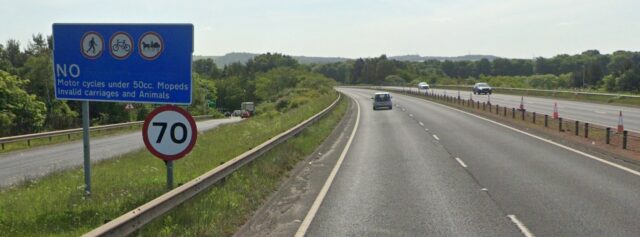
To get there, we need a history lesson.
As early as the 1930s, it was becoming clear that Britain might one day need a network of high-speed, motor-vehicle-only roads: motorways. The first experimental part of this network would be the Preston By-pass1.
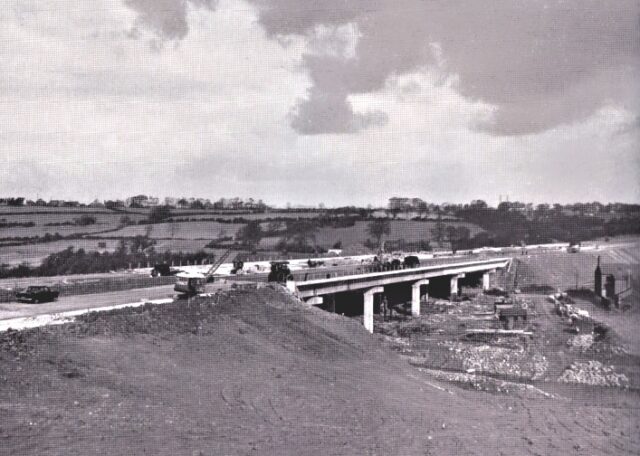
Construction wouldn’t actually begin until the 1950s, and it wasn’t just the Second World War that got in the way: there was a legislative challenge too.
When the Preston By-pass was first conceived, there was no legal recognition for roads that restricted the types of traffic that were permitted to drive on them. If a public highway were built, it would have to allow pedestrians, cyclists, and equestrians, which would doubtless undermine the point of the exercise! Before it could be built, the government needed to pass the Special Roads Act 1949, which enabled the designation of public roads as “special roads”, to which entry could be limited to certain classes of vehicles2.
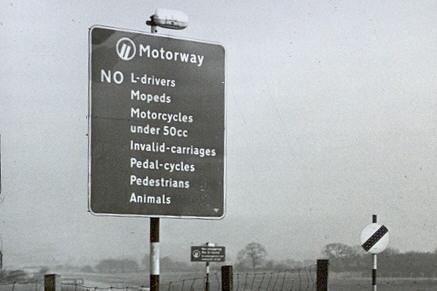
If you don’t check your sources carefully when you research the history of special roads, you might be taken in by articles that state that special roads are “now known as motorways”, which isn’t quite true. All motorways are special roads, by definition, but not all special roads are motorways.
There’s maybe a dozen or more non-motorway special roads, based on research by Pathetic Motorways (whose site was amazingly informative on this entire subject). They tend to be used in places where something is like a motorway, but can’t quite be a motorway. In Manchester, a couple of the A57(M)’s sliproads have pedestrian crossings and so have to be designated special roads rather than motorways, for example3.
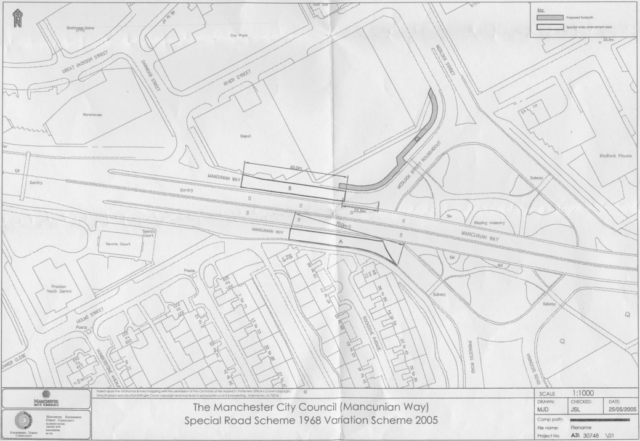
Now we know what special roads are, that we might find them all over the place, and that they can superficially look like motorways, let’s talk about speed limits.
The Road Traffic Act 1934 introduced the concept of a 30mph “national speed limit” in built-up areas, which is still in force today. But outside of urban areas there was no speed limit. Perhaps there didn’t need to be, while cars were still relatively slow, but automobiles became increasingly powerful. The fastest speed ever legally achieved on a British motorway came in 1964 during a test by AC Cars, when driver Jack Sears reached 185mph.
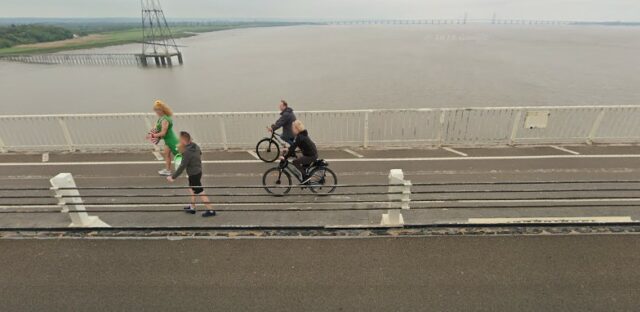
In the late 1960s an experiment was run in setting a speed limit on motorways of 70mph. Then the experiment was extended. Then the regulation was made permanent.
There’ve been changes since then, e.g. to prohibit HGVs from going faster than 60mph, but fundamentally this is where Britain’s national speed limit on motorways comes from.

You’ve probably spotted the quirk already. When “special roads” were created, they didn’t have a speed limit. Some “special roads” were categorised as “motorways”, and “motorways” later had a speed limit imposed. But there are still a few non-motorway “special roads”!
Putting a national speed limit sign on a special road would be meaningless, because these roads have no centrally-legislated speed limit. So they need a speed limit sign, even if that sign, confusingly, might specify a speed limit that matches what you’d have expected on such a road4. That’s the (usual) reason why you sometimes see these surprising signs.
As to why this kind of road are much more-common in Scotland and Wales than they are anywhere else in the UK: that’s a much deeper-dive that I’ll leave as an exercise for the reader.
1 The Preston By-pass lives on, broadly speaking, as the M6 junctions 29 through 32.
2 There’s little to stop a local authority using the powers of the Special Roads Act and its successors to declare a special road accessible to some strange and exotic permutation of vehicle classes if they really wanted: e.g. a road could be designated for cyclists and horses but forbidden to motor vehicles and pedestrians, for example! (I’m moderately confident this has never happened.)
3 There’s a statutory instrument that makes those Mancunian sliproads possible, if you’re having trouble getting to sleep on a night and need some incredibly dry reading.
4 An interesting side-effect of these roads might be that speed restrictions based on the class of your vehicle and the type of road, e.g. 60mph for lorries on motorways, might not be enforceable on special roads. If you wanna try driving your lorry at 70mph on a motorway-like special road with “70” signs, though, you should do your own research first; don’t rely on some idiot from the Internet. I Am Not A Lawyer etc. etc.
This post1 is part of my attempt at Bloganuary 2024.2Today’s prompt is:
Think back on your most memorable road trip.
It didn’t take me long to choose a most-memorable road trip, but first: here’s a trio of runners-up that I considered3:
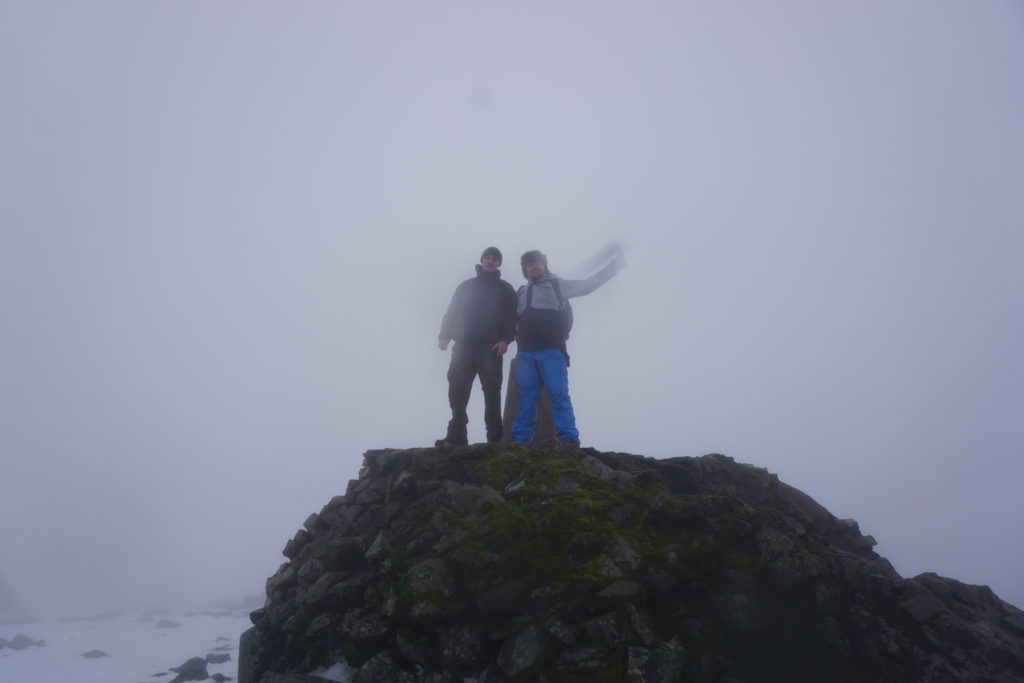

At somewhere between 500 and 600 road miles each way, perhaps the single longest road journey I’ve ever made without an overnight break was to attend a wedding.
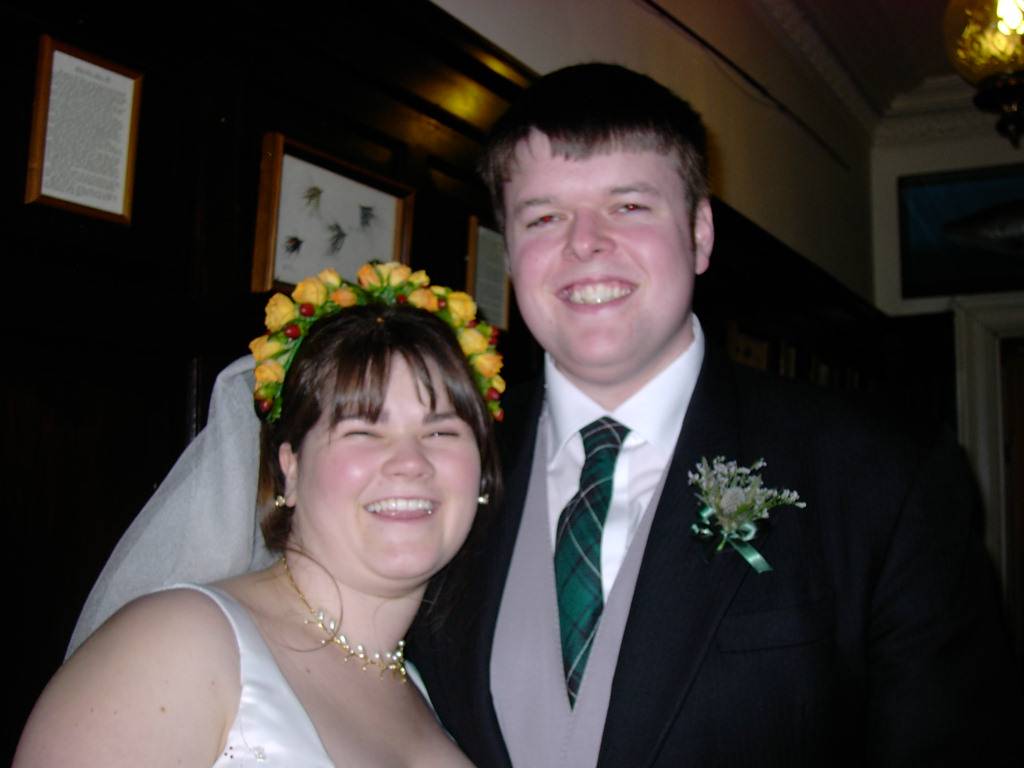
The wedding was of my friends Kit and Fi, and took place a long, long way up into Scotland. At the time I (and a few other wedding guests) lived on the West coast of Wales. The journey options between the two might be characterised as follows:
Guess which approach this idiot went for?
Despite having just graduated, I was still living very-much on a student-grade budget. I wasn’t confident that we could afford both the travel to and from the wedding and more than a single night’s accommodation at the other end.
But there were four of us who wanted to attend: me, my partner Claire, and our friends Bryn and Paul. Two of the four were qualified to drive and could be insured on Claire’s car8. This provided an opportunity: we’d make the entire 11-or-so-hour journey by car, with a pair of people sleeping in the back while the other pair drove or navigated!
It was long, and it was arduous, but we chatted and we sang and we saw a frankly ludicrous amount of the A9 trunk road and we made it to and from what was a wonderful wedding on our shoestring budget. It’s almost a shame that the party was so good that the memories of the road trip itself pale, or else this might be a better anecdote! But altogether, entirely a worthwhile, if crazy, exercise.
1 Participating in Bloganuary has now put me into my fifth-longest “daily streak” of blog posts! C-c-c-combo continues!
2 Also, wow: thanks to staying up late with my friend John drinking and mucking about with the baby grand piano in the lobby of the hotel we’re staying at, I might be first to publish a post for today’s Bloganuary!
3 Strangely, all three of the four journeys I’ve considered seem to involve Scotland. Which I suppose shouldn’t be too much of a surprise, given its distance from many of the other places I’ve lived and of course its size (and sometimes-sparse road network).
4 Okay, probably not for the entire journey, but I’m certain it must’ve felt like it.
5 Our cargo included several cats who almost-immediately escaped from their cardboard enclosures and vomited throughout the vehicle.
6 This included, for example, our beds: we spent our first night in our new house camped together in sleeping bags on the floor of what would later become my bedroom, which only added to the sense of adventure in the whole enterprise.
7 It was, fortunately, only a light vehicle, plus our designated driver was at this point so pumped-up on energy drinks he might have been able to lift it by himself!
8 It wasn’t a big car, and in hindsight cramming four people into it for such a long journey might not have been the most-comfortable choice!
I swear I’m onto something with this idea: Scottish-Mexican fusion cookery. Hear me out.
It started on the last day of our trip to the Edinburgh Fringe Festival in 2012 when, in an effort to use up our self-catering supplies, JTA suggested (he later claimed this should have been taken as a joke) haggis tacos. Ruth and I ate a whole bunch of them and they were great.
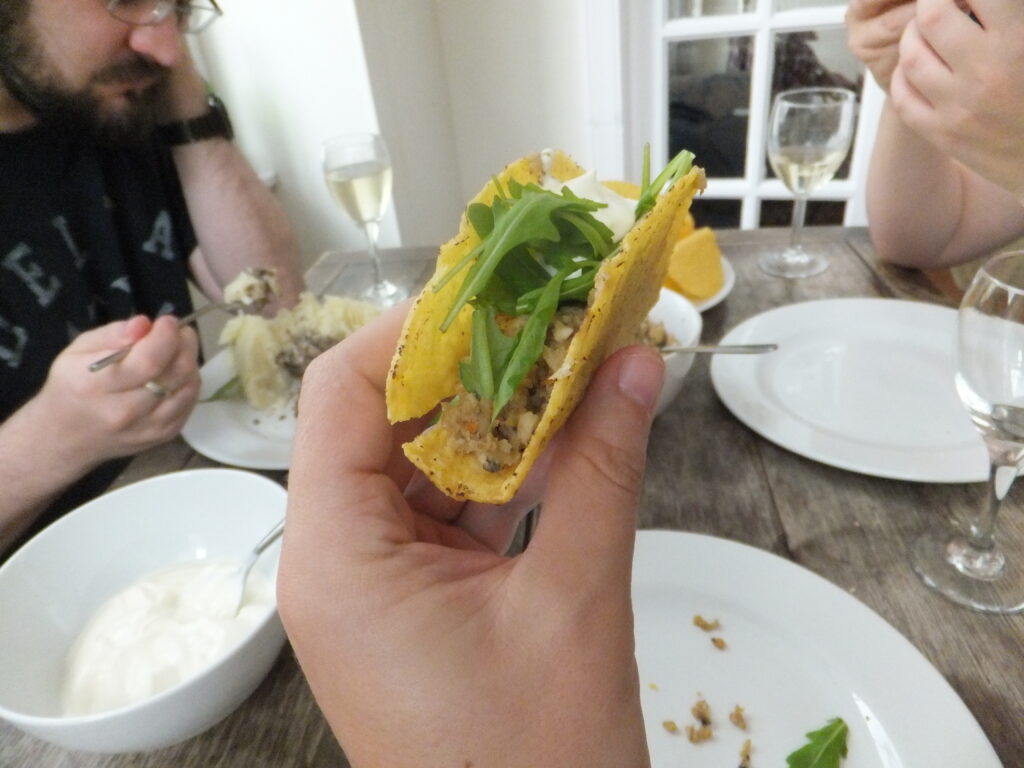
In Scotland last week (while I wasn’t climbing mountains and thinking of my father), Ruth and I came up with our second bit of Scottish-Mexican fusion food: tattie scone quesadillas. Just sandwich some cheese and anything else you like between tattie scones and gently fry in butter.
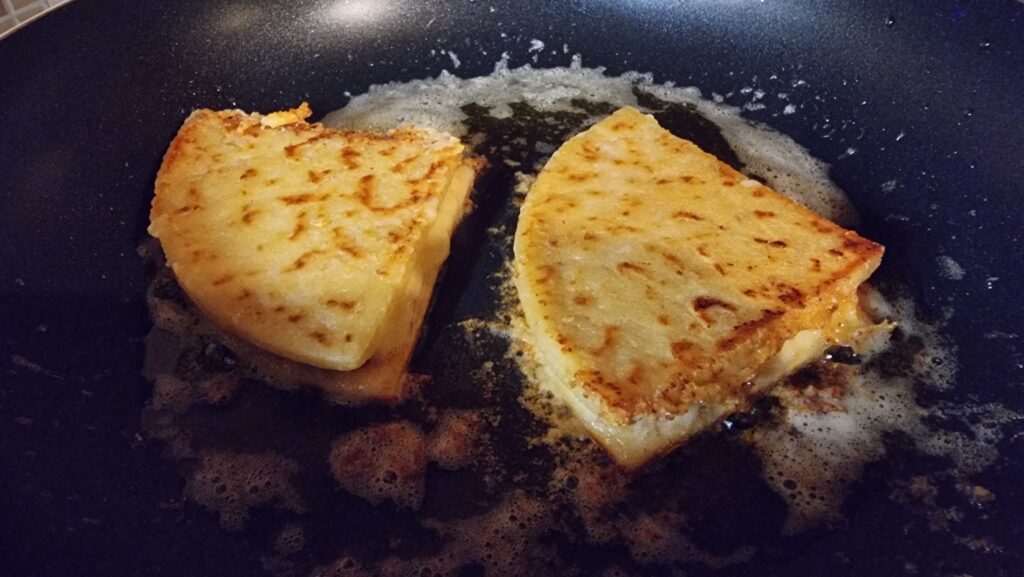
We’re definitely onto something. But what to try next? How about…
Is there a name for that experience when you forget for a moment that somebody’s dead?
For a year or so after my dad’s death 11 years ago I’d routinely have that moment: when I’d go “I should tell my dad about this!”, followed immediately by an “Oh… no, I can’t, can I?”. Then, of course, it got rarer. It happened in 2017, but I don’t know if it happened again after that – maybe once? – until last week.

I wonder if subconsciously I was aware that the anniversary of his death – “Dead Dad Day”, as my sisters and I call it – was coming up? In any case, when I found myself on Cairn Gorm on a family trip and snapped a photo from near the summit, I had a moment where I thought “I should send this picture to my dad”, before once again remembering that nope, that wasn’t possible.
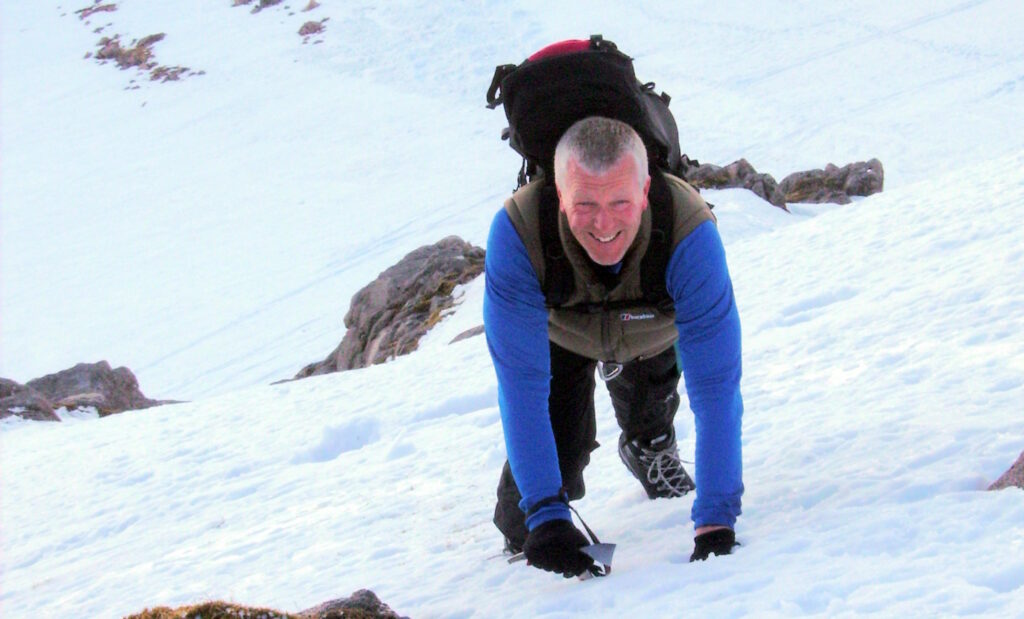
Strange that this can still happen, over a decade on. If there’s a name for the phenomenon, I’d love to know it.
This is a repost promoting content originally published elsewhere. See more things Dan's reposted.
…
This adventure took a lot of planning. It’s 350 miles from where I live to Glasgow. I have a Honda CG 125cc, and my maximum range in one day is around 200 miles – if I have the full day for travelling, which I wouldn’t have, most days. I figured if I was going to have a road trip, I’d have to make stop offs at various parts of the UK, to break it up. This actually worked out really well, as there are lots of parts of the UK that I wanted to visit.
…
After booking the series of hotel rooms, I started to think about the actual riding. It was two weeks before the trip. I didn’t have enough thermals, or a bike suit that was protective enough. I also didn’t have a way of storing luggage on my bike, or keeping it dry (and two laptops would be in the bags). There was also an issue with the chain on my bike that needed fixing. Not exactly a trivial to do list! So the next two weeks turned into a bit of an eBay and Amazon frenzy, with a trip down to see my dad in Kent to get the bike chain fixed, and rummage around for my old waterproofs in my grandparent’s attic. It was pretty close: the final item arrived the day before the trip. I got ridiculously lucky on eBay with my new, more visible, better padded, comfy bike suit though, which I love to bits. In hindsight, more time for all of this would have been helpful!
…
My friend Bev wrote about their motorcycling adventure up and down the UK; it’s pretty awesome.
We might never have been very good at keeping track of the exact date our relationship began in Edinburgh twelve years ago, but that doesn’t stop Ruth and I from celebrating it, often with a trip away very-approximately in the summer. This year, we marked the occasion with a return to Scotland, cycling our way around and between Glasgow and Edinburgh.
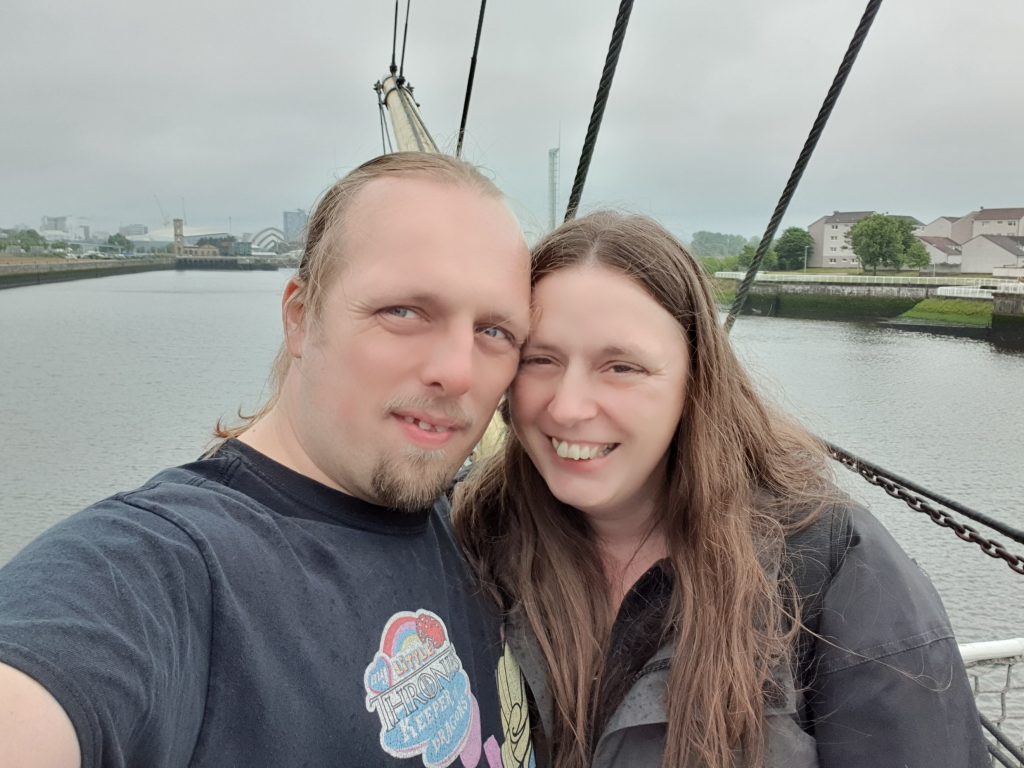
Even sharing a lightweight conventional bike and a powerful e-bike, travelling under your own steam makes you pack lightly. We were able to get everything we needed – including packing for the diversity of weather we’d been told to expect – in a couple of pannier bags and a backpack, and pedalled our way down to Oxford Parkway station to start our journey.
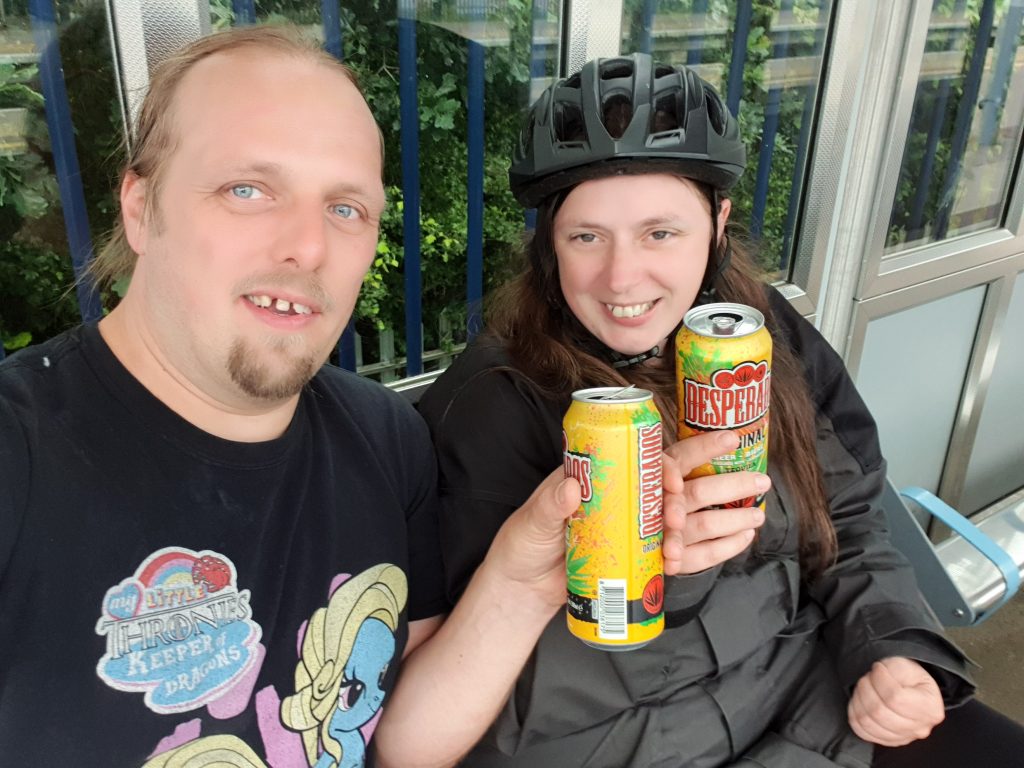
In anticipation of our trip and as a gift to me, Ruth had arranged for tickets on the Caledonian Sleeper train from London to Glasgow and returning from Edinburgh to London to bookend our adventure. A previous sleeper train ticket she’d purchased, for Robin as part of Challenge Robin II, had lead to enormous difficulties when the train got cancelled… but how often can sleeper trains get cancelled, anyway?
![Digital display board: "Passengers for the Caledonian Sleeper service tonight departing at 23:30 are being advised that the Glasgow portio [sic] of this service has been cancelled. For further information please see staff on"](https://bcdn.danq.me/_q23u/2019/06/20190623_222859-1024x498.jpg)
Station staff advised us that instead of a nice fast train full of beds they’d arranged for a grotty slow bus full of disappointment. It took quite a bit of standing-around and waiting to speak to the right people before anybody could even confirm that we’d be able to stow our bikes on the bus, without which our plans would have been completely scuppered. Not a great start!

Eight uncomfortable hours of tedious motorway (and the opportunity to wave at Oxford as we went back past it) and two service stations later, we finally reached Glasgow.
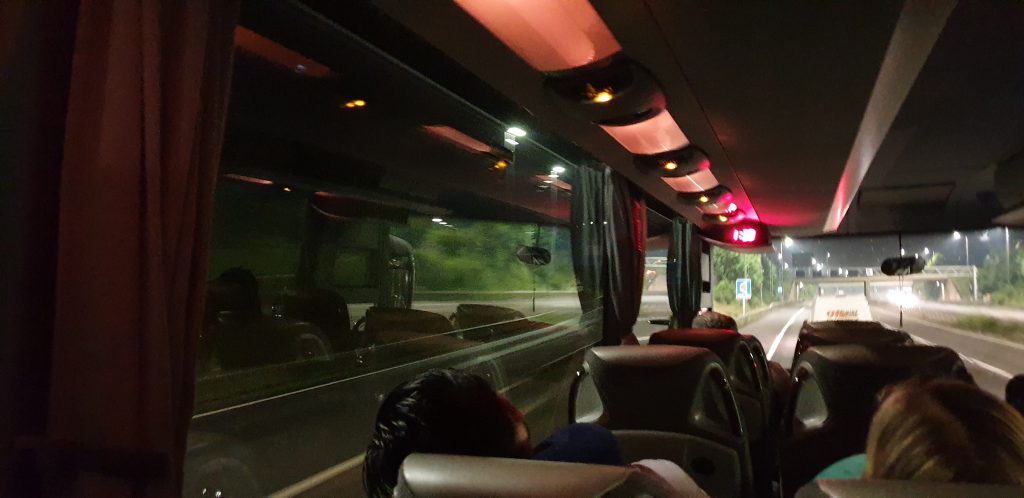
Despite being tired and in spite of the threatening stormclouds gathering above, we pushed on with our plans to explore Glasgow. We opted to put our trust into random exploration – aided by responses to weirdly-phrased questions to Google Assistant about what we should see or do – to deliver us serendipitous discoveries, and this plan worked well for us. Glasgow’s network of cycle paths and routes seems to be effectively-managed and sprawls across the city, and getting around was incredibly easy (although it’s hilly enough that I found plenty of opportunities to require the lowest gears my bike could offer).

We kicked off by marvelling at the extravagance of the memorials at Glasgow Necropolis, a sprawling 19th-century cemetery covering an entire hill near the city’s cathedral. Especially towards the top of the hill the crypts and monuments give the impression that the dead were competing as to who could leave the most-conspicuous marker behind, but there are gems of subtler and more-attractive Gothic architecture to be seen, too. Finding a convenient nearby geocache completed the experience.
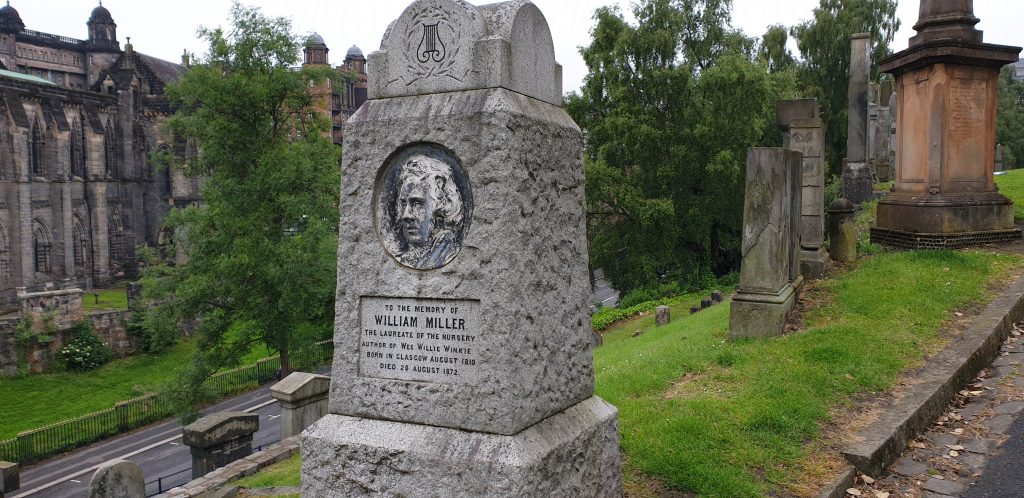
Pushing on, we headed downriver in search of further adventure… and breakfast. The latter was provided by the delightful Meat Up Deli, who make a spectacularly-good omelette. There, in the shadow of Partick Station, Ruth expressed surprise at the prevalence of railway stations in Glasgow; she, like many folks, hadn’t known that Glasgow is served by an underground train network, But I too would get to learn things I hadn’t known about the subway at our next destination.
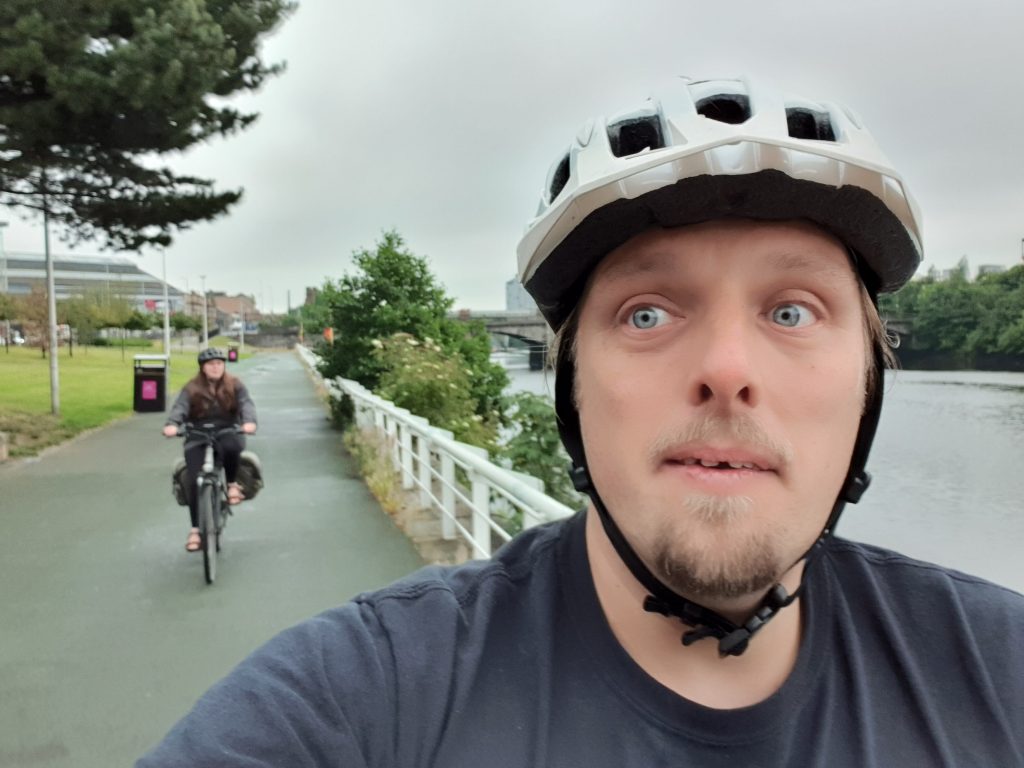
We visited the Riverside Museum, whose exhibitions are dedicated to the history of transport and industry, with a strong local focus. It’s a terrifically-engaging museum which does a better-than-usual job of bringing history to life through carefully-constructed experiences. We spent much of the time remarking on how much the kids would love it… but then remembering that the fact that we were able to enjoy stopping and read the interpretative signage and not just have to sprint around after the tiny terrors was mostly thanks to their absence! It’s worth visiting twice, if we find ourselves up here in future with the little tykes.

It’s also where I learned something new about the Glasgow Subway: its original implementation – in effect until 1935 – was cable-driven! A steam engine on the South side of the circular network drove a pair of cables – one clockwise, one anticlockwise, each 6½ miles long – around the loop, between the tracks. To start the train, a driver would pull a lever which would cause a clamp to “grab” the continuously-running cable (gently, to prevent jerking forwards!); to stop, he’d release the clamp and apply the brakes. This solution resulted in mechanically-simple subway trains: the system’s similar to that used for some of the surviving parts of San Franciso’s original tram network.
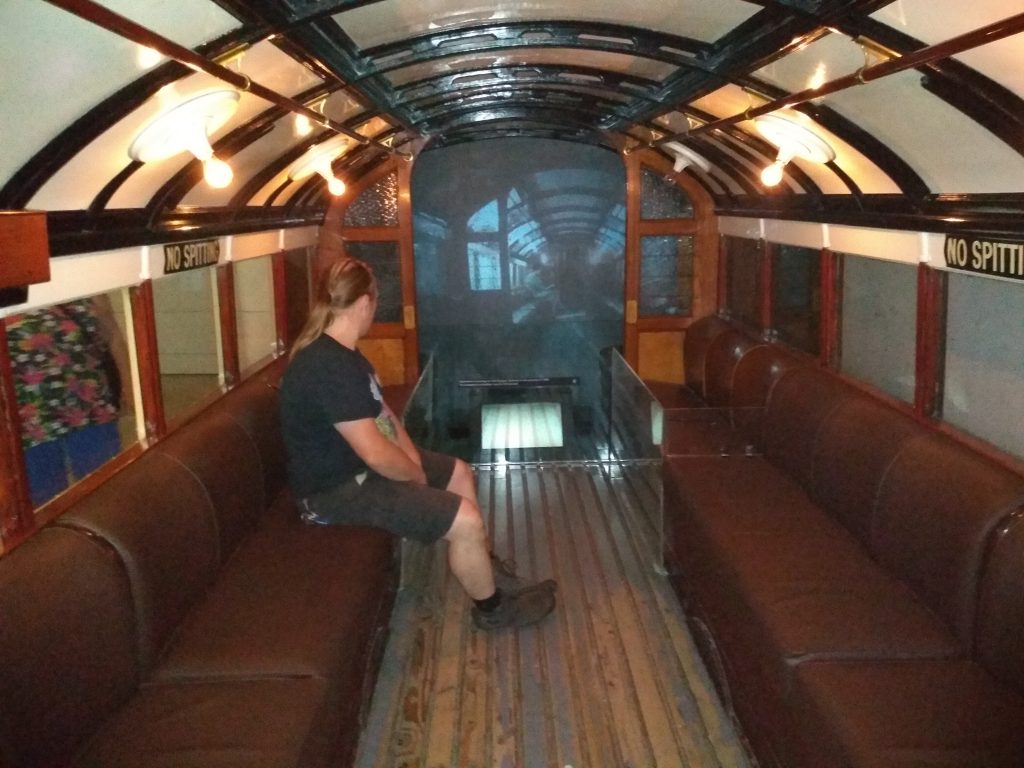
Equally impressive as the Riverside Museum is The Tall Ship accompanying it, comprising the barque Glenlee converted into a floating museum about itself and about the maritime history of its age.
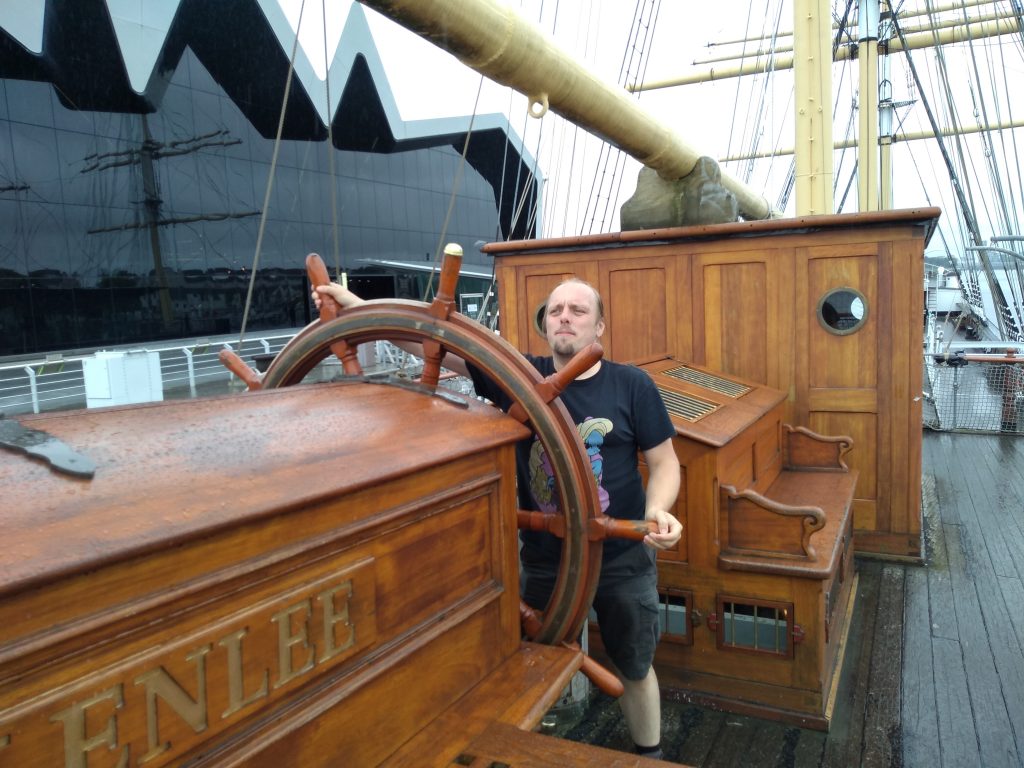
This, again, was an incredibly well-managed bit of culture, with virtually the entire ship accessible to visitors, right down into the hold and engine room, and with a great amount of effort put into producing an engaging experience supported by a mixture of interactive replicas (Ruth particularly enjoyed loading cargo into a hoist, which I’m pretty sure was designed for children), video, audio, historical sets, contemporary accounts, and all the workings of a real, functional sailing vessel.

After lunch at the museum’s cafe, we doubled-back along the dockside to a distillery we’d spotted on the way past. The Clydeside Distillery is a relative newcomer to the world of whisky – starting in 2017, their first casks are still several years’ aging away from being ready for consumption, but that’s not stopping them from performing tours covering the history of their building (it’s an old pumphouse that used to operate the swingbridge over the now-filled-in Queen’s Dock) and distillery, cumulating in a whisky tasting session (although not yet including their own single malt, of course).
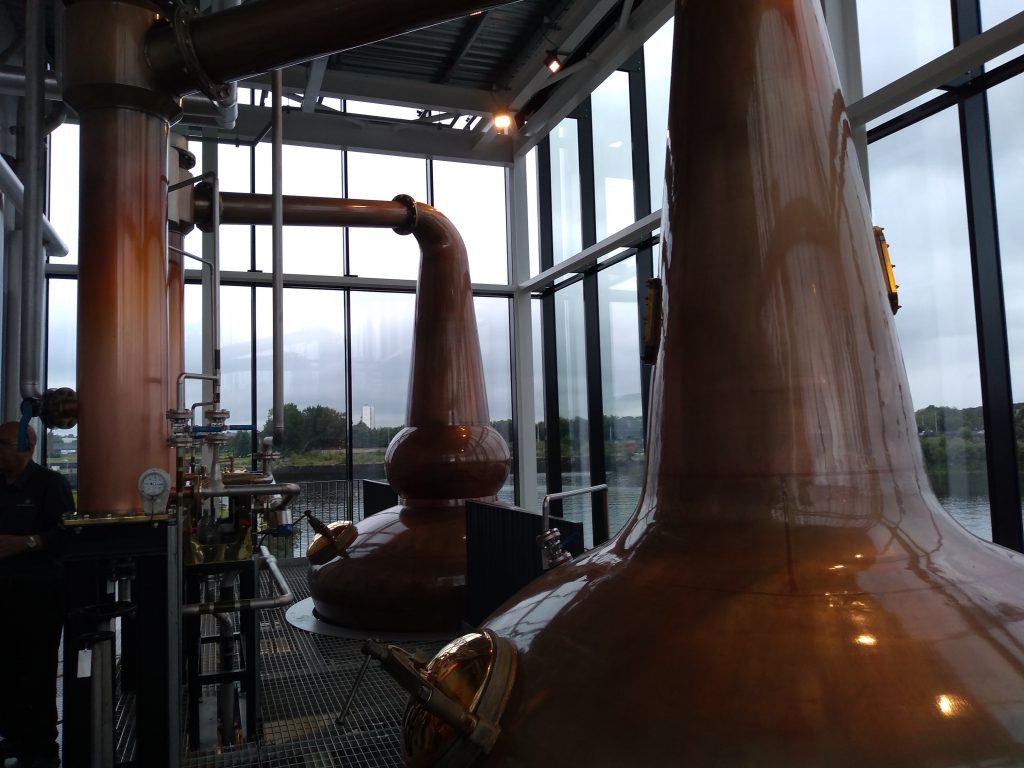
This was the first time Ruth and I had attended a professionally-organised whisky-tasting together since 2012, when we did so not once but twice in the same week. Fortunately, it turns out that we hadn’t forgotten how to drink whisky; we’d both kept our hand in in the meantime. <hic> Oh, and we got to keep our tasting-glasses as souvenirs, which was a nice touch.
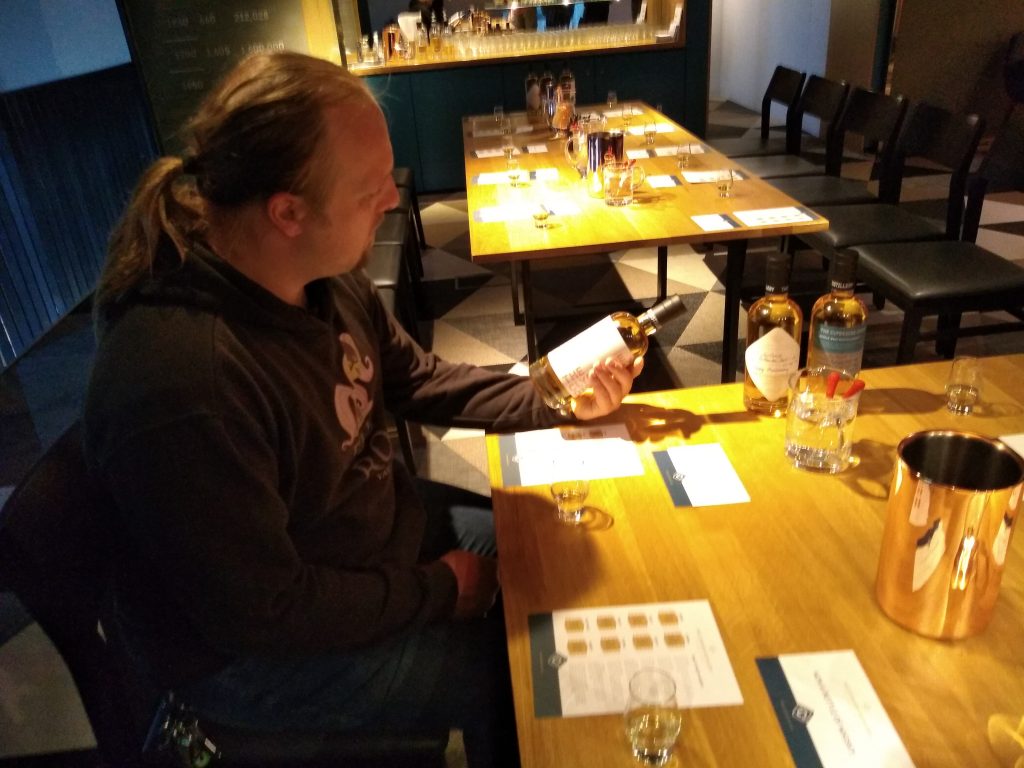
Thus far we’d been lucky that the rain had mostly held-off, at least while we’d been outdoors. But as we wrapped up in Glasgow and began our cycle ride down the towpath of the Forth & Clyde Canal, the weather turned quickly through bleak to ugly to downright atrocious. The amber flood warning we’d been given gave way to what forecasters and the media called a “weather bomb”: an hours-long torrential downpour that limited visibility and soaked everything left out in it.
You know: things like us.
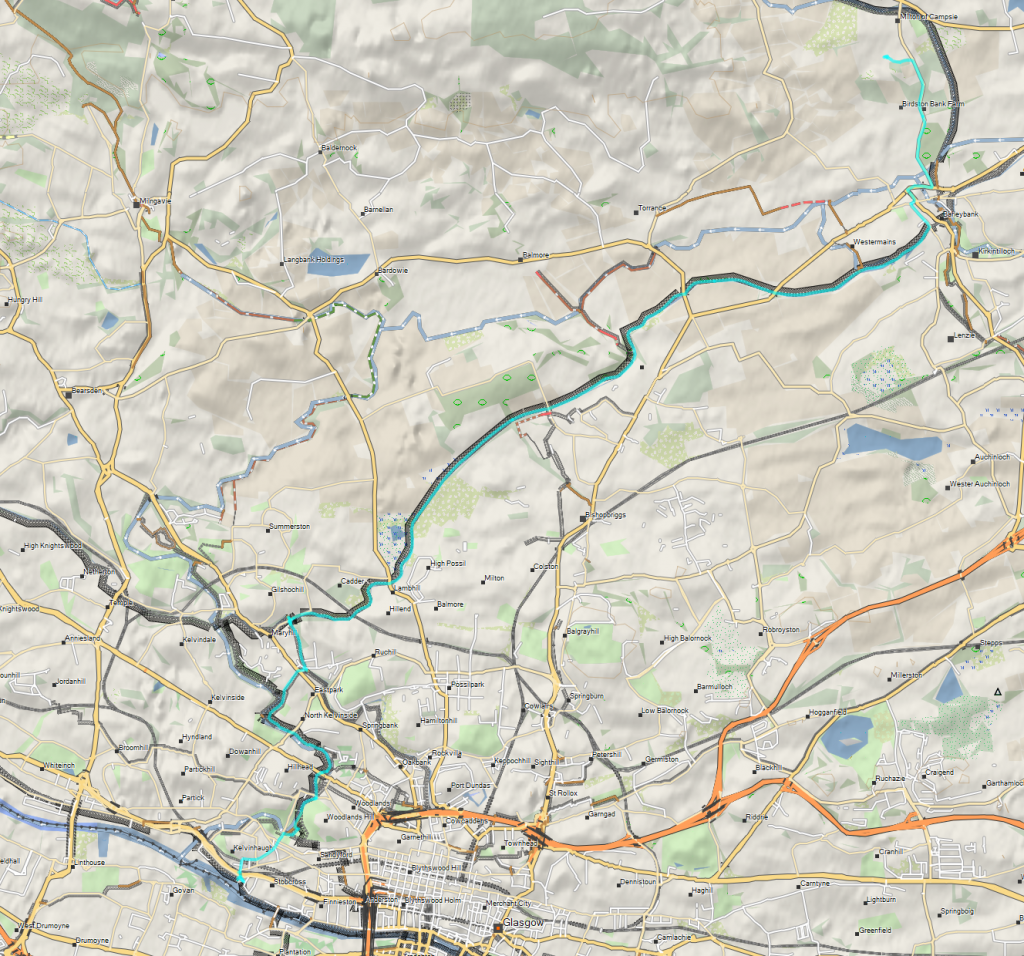
Our bags held up against the storm, thankfully, but despite an allegedly-waterproof covering Ruth and I both got thoroughly drenched. By the time we reached our destination of Kincaid House Hotel we were both exhausted (not helped by a lack of sleep the previous night during our rail-replacement-bus journey) and soaking wet right through to our skin. My boots squelched with every step as we shuffled uncomfortably like drowned rats into a hotel foyer way too-fancy for bedraggled waifs like us.
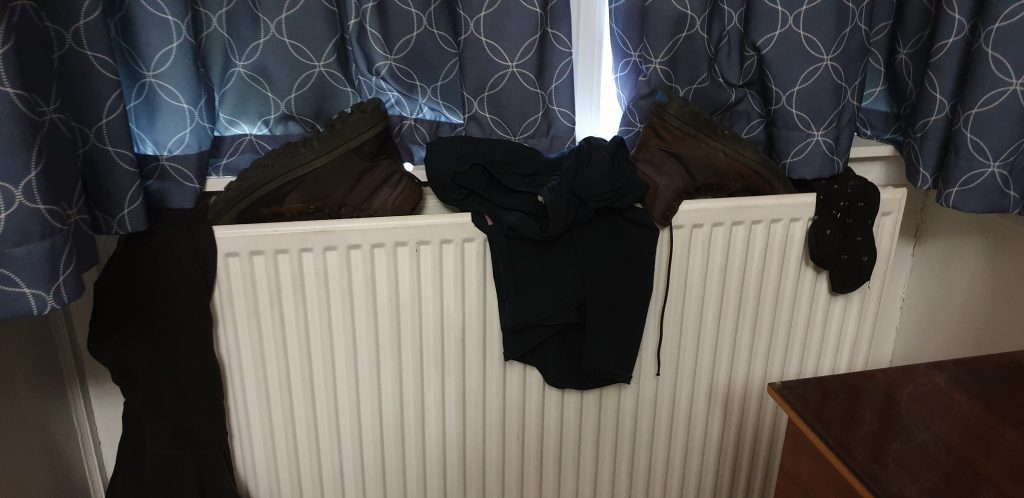
We didn’t even have the energy to make it down to dinner, instead having room service delivered to the room while we took turns at warming up with the help of a piping hot bath. If I can sing the praises of Kincaid House in just one way, though, it’s that the food provided by room service was absolutely on-par with what I’d expect from their restaurant: none of the half-hearted approach I’ve experienced elsewhere to guests who happen to be too knackered (and in my case: lacking appropriate footwear that’s not filled with water) to drag themselves to a meal.

Our second day of cycling was to be our longest, covering the 87½ km (54½ mile) stretch of riverside and towpath between Milton of Campsie and our next night’s accommodation on the South side of Edinburgh. We were wonderfully relieved to discover that the previous day’s epic dump of rain had used-up the clouds’ supply in a single day and the forecast was far more agreeable: cycling 55 miles during a downpour did not sound like a fun idea for either of us!
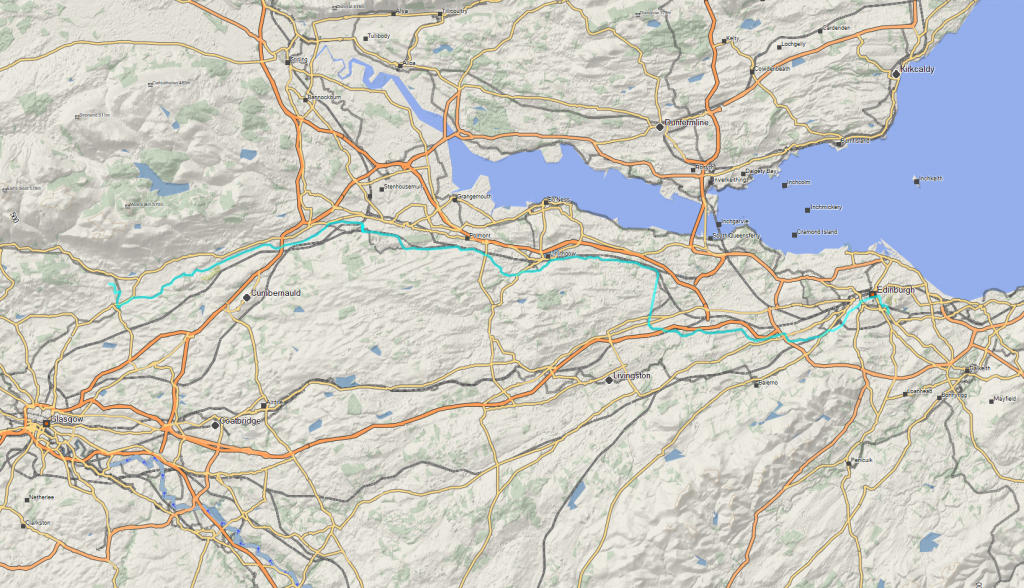
Kicking off by following the Strathkelvin Railway Path, Ruth and I were able to enjoy verdant countryside alongside a beautiful brook. The signs of the area’s industrial past are increasingly well-concealed – a rotting fence made of old railway sleepers here; the remains of a long-dead stone bridge there – and nature has reclaimed the land dividing this former-railway-now-cycleway from the farmland surrounding it. Stopping briefly for another geocache we made good progress down to Barleybank where we were able to rejoin the canal towpath.

This is where we began to appreciate the real beauty of the Scottish lowlands. I’m a big fan of a mountain, but there’s also a real charm to the rolling wet countryside of the Lanarkshire valleys. The Forth & Clyde towpath is wonderfully maintained – perhaps even better than the canal itself, which is suffering in patches from a bloom of spring reeds – and makes for easy cycling.
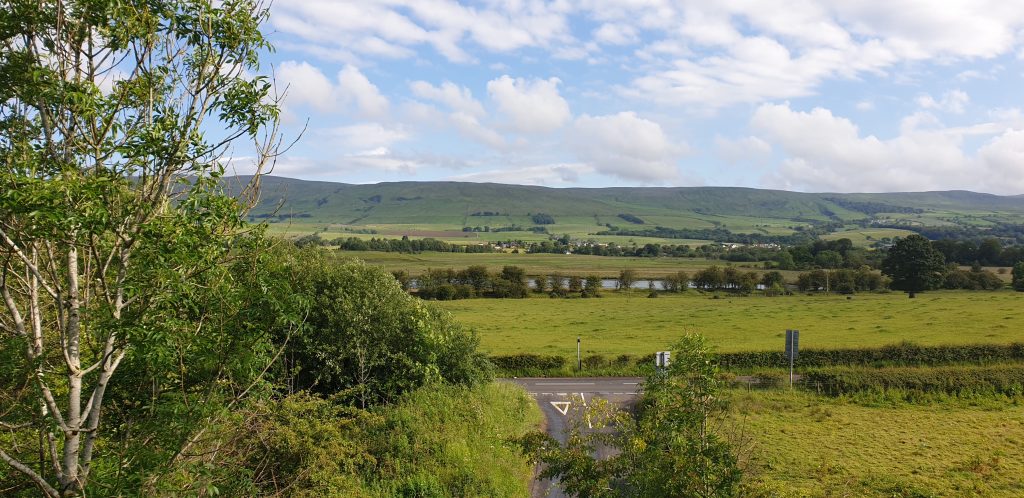
Outside of moorings at the odd village we’d pass, we saw no boats along most of the inland parts of the Forth & Clyde canal. We didn’t see many joggers, or dog-walkers, or indeed anybody for long stretches.
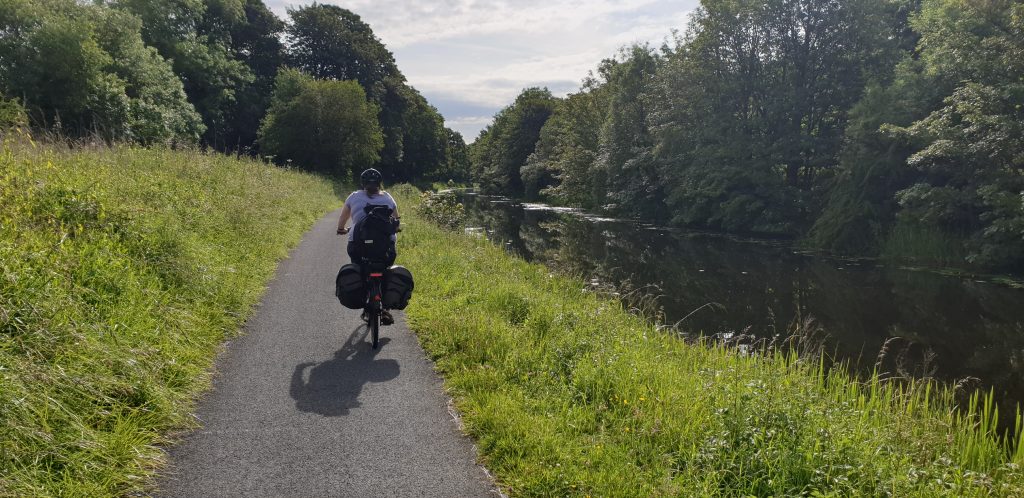
The canal was also teeming with wildlife. We had to circumnavigate a swarm of frogs, spotted varied waterfowl including a heron who’d decided that atop a footbridge was the perfect place to stand and a siskin that made itself scarce as soon as it spotted us, and saw evidence of water voles in the vicinity. The rushes and woodland all around but especially on the non-towpath side of the canal seemed especially popular with the local fauna as a place broadly left alone by humans.

The canal meanders peacefully, flat and lock-free, around the contours of the Kelvin valley all the way up to the end of the river. There, it drops through Wyndford Lock into the valley of Bonny Water, from which the rivers flow into the Forth. From a hydrogeological perspective, this is the half-way point between Edinburgh and Glasgow.

Seven years ago, I got the chance to visit the Falkirk Wheel, but Ruth had never been so we took the opportunity to visit again. The Wheel is a very unusual design of boat lift: a pair of counterbalanced rotating arms swap places to move entire sections of the canal from the lower to upper level, and vice-versa. It’s significantly faster to navigate than a flight of locks (indeed, there used to be a massive flight of eleven locks a little way to the East, until they were filled in and replaced with parts of the Wester Hailes estate of Falkirk), wastes no water, and – because it’s always in a state of balance – uses next to no energy to operate: the hydraulics which push it oppose only air resistance and friction.
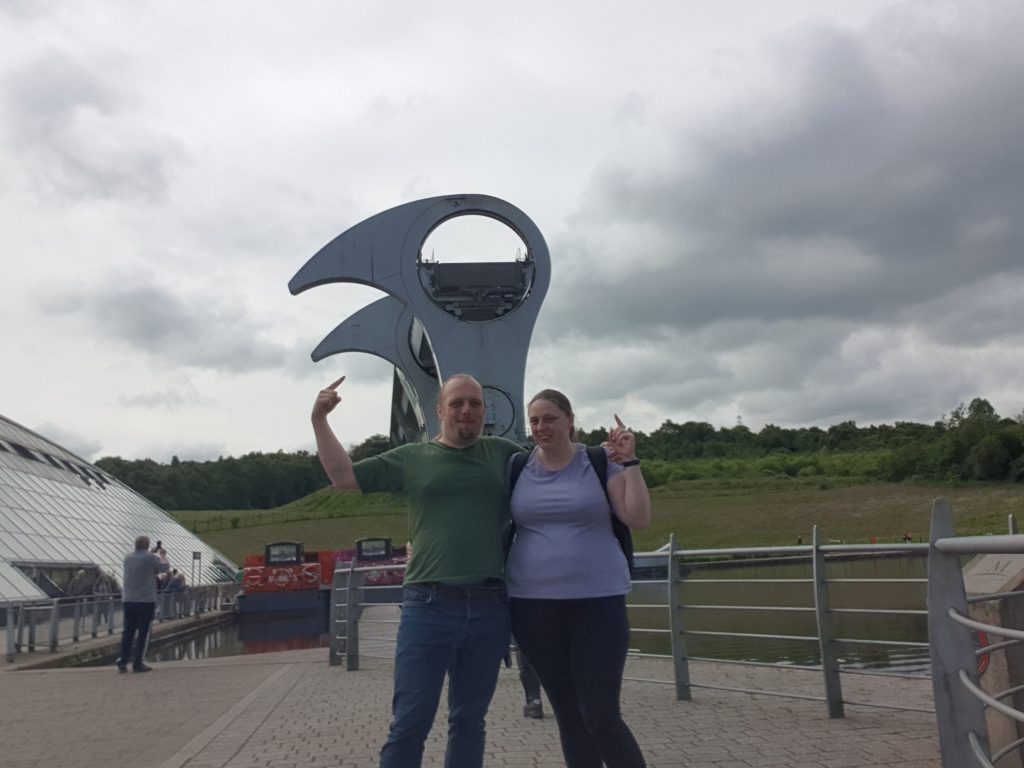
So naturally, we took a boat ride up and down the wheel, recharged our batteries (metaphorically; the e-bike’s battery would get a top-up later in the day) at the visitor centre cafe, and enjoyed listening-in to conversations to hear the “oh, I get it” moments of people – mostly from parts of the world without a significant operating canal network, in their defence – learning how a pound lock works for the first time. It’s a “lucky 10,000” thing.
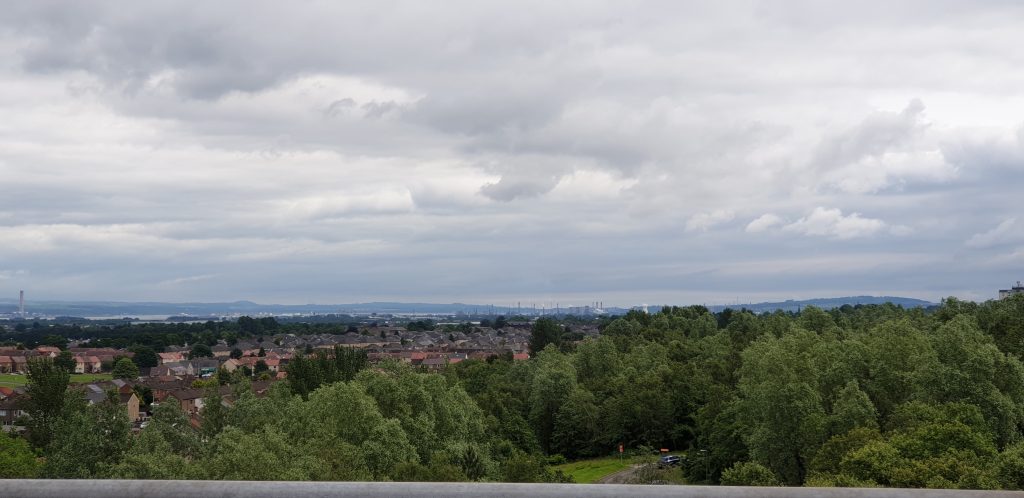
Pressing on, we cycled up the hill. We felt a bit cheated, given that we’d just been up and down pedal-free on the boat tour, and this back-and-forth manoeuvrer confused my GPSr – which was already having difficulty with our insistence on sticking to the towpath despite all the road-based “shortcuts” it was suggesting – no end!

From the top of the Wheel we passed through Rough Castle Tunnel and up onto the towpath of the Union Canal. This took us right underneath the remains of the Antonine Wall, the lesser-known sibling of Hadrian’s Wall and the absolute furthest extent, albeit short-lived, of the Roman Empire on this island. (It only took the Romans eight years to realise that holding back the Caledonian Confederacy was a lot harder work than their replacement plan: giving most of what is now Southern Scotland to the Brythonic Celts and making the defence of the Northern border into their problem.)
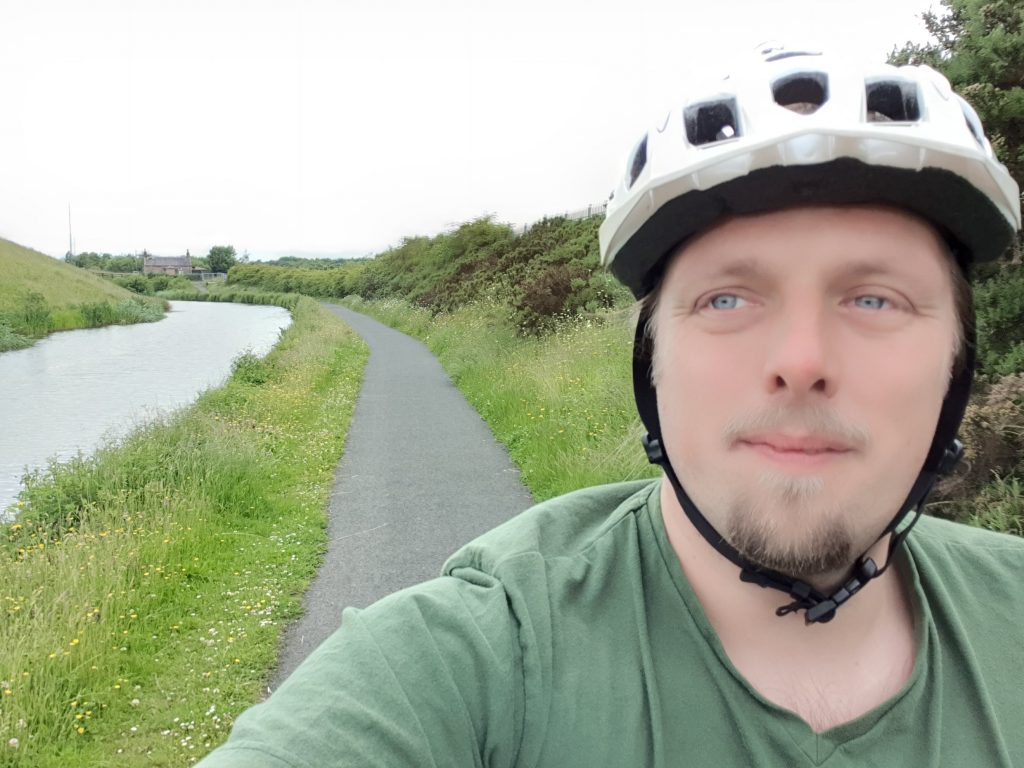
A particular joy of this section of waterway was the Falkirk Tunnel, a very long tunnel broad enough that the towpath follows through it, comprised of a mixture of hewn rock and masonry arches and very variable in height (during construction, unstable parts of what would have been the ceiling had to be dug away, making it far roomier than most narrowboat canal tunnels).
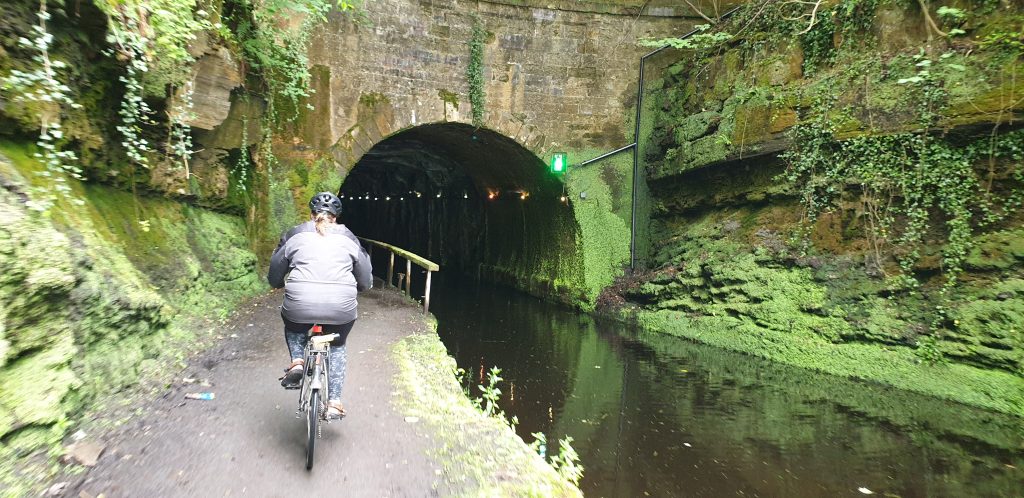
Wet, cold, slippery, narrow, and cobblestoned for the benefit of the horses that no-longer pull boats through this passage, we needed to dismount and push our bikes through. This proved especially challenging when we met other cyclists coming in the other direction, especially as our e-bike (as the designated “cargo bike”) was configured in what we came to lovingly call “fat ass” configuration: with pannier bags sticking out widely and awkwardly on both sides.
This is probably the oldest tunnel in Scotland, known with certainty to predate any of the nation’s railway tunnels. The handrail was added far later (obviously, as it would interfere with the reins of a horse), as were the mounted electric lights. As such, this must have been a genuinely challenging navigation hazard for the horse-drawn narrowboats it was built to accommodate!
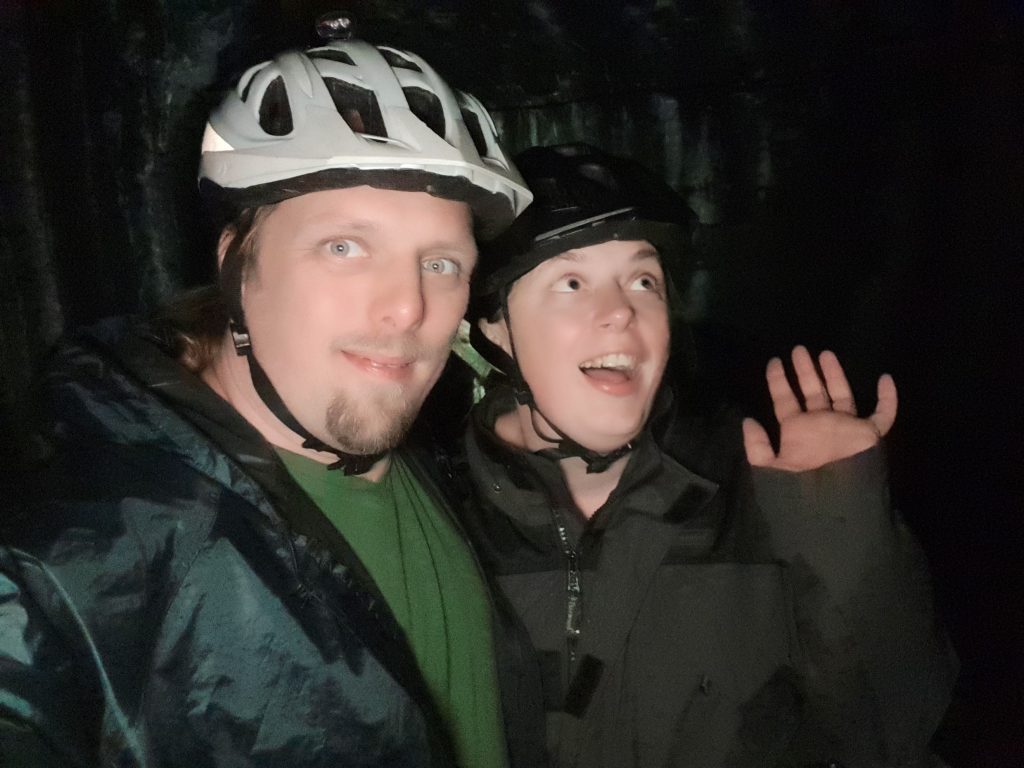
On the other side the canal passes over mighty aqueducts spanning a series of wooded valleys, and also providing us with yet another geocaching opportunity. We were very selective about our geocache stops on this trip; there were so many candidates but we needed to make progress to ensure that we made it to Edinburgh in good time.
We took lunch and shandy at Bridge 49 where we also bought a painting depicting one of the bridges on the Union Canal and negotiated with the proprietor an arrangement to post it to us (as we certainly didn’t have space for it in our bags!), continuing a family tradition of us buying art from and of places we take holidays to. They let us recharge our batteries (literal this time: we plugged the e-bike in to ensure it’d have enough charge to make it the rest of the way without excessive rationing of power). Eventually, our bodies and bikes refuelled, we pressed on into the afternoon.
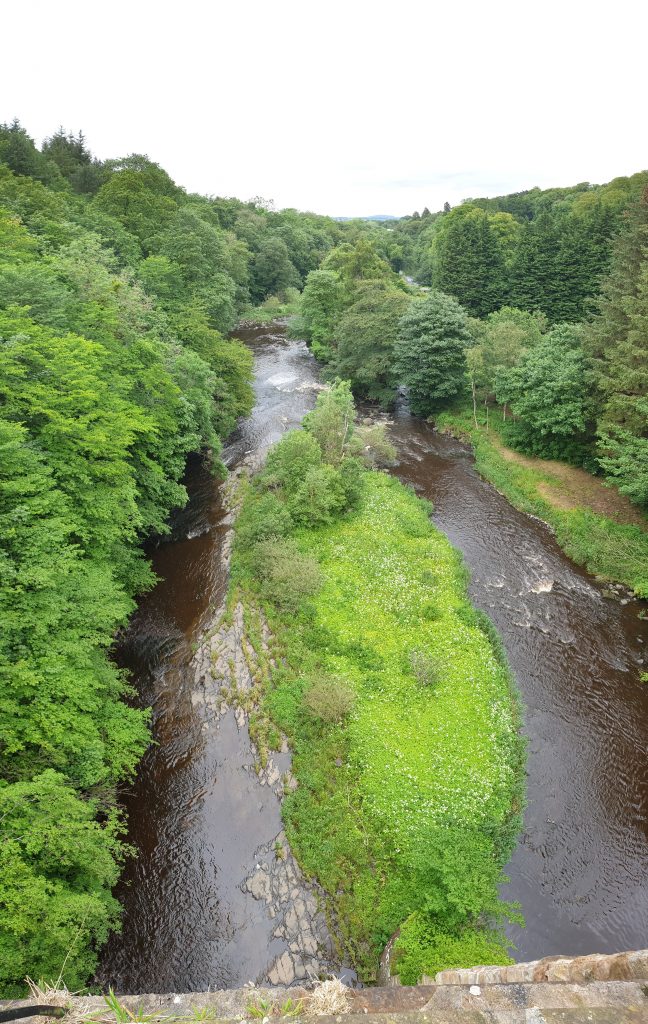
For all that we might scoff at the overly-ornate, sometimes gaudy architecture of the Victorian era – like the often-ostentatious monuments of the Necropolis we visited early in our adventure – it’s still awe-inspiring to see their engineering ingenuity. When you stand on a 200-year-old aqueduct that’s still standing, still functional, and still objectively beautiful, it’s easy to draw unflattering comparisons to the things we build today in our short-term-thinking, “throwaway” culture. Even the design of the Falkirk Wheel’s, whose fate is directly linked to these duocentenarian marvels, only called for a 120-year lifespan. How old is your house? How long can your car be kept functioning? Long-term thinking has given way to short-term solutions, and I’m not convinced that it’s for the better.

Eventually, and one further (especially sneaky) geocache later, a total of around 66 “canal miles”, one monsoon, and one sleep from the Glasgow station where we dismounted our bus, we reached the end of the Union Canal in Edinburgh.

There we checked in to the highly-recommendable 94DR guest house where our host Paul and his dog Molly demonstrated their ability to instantly-befriend just-about anybody.
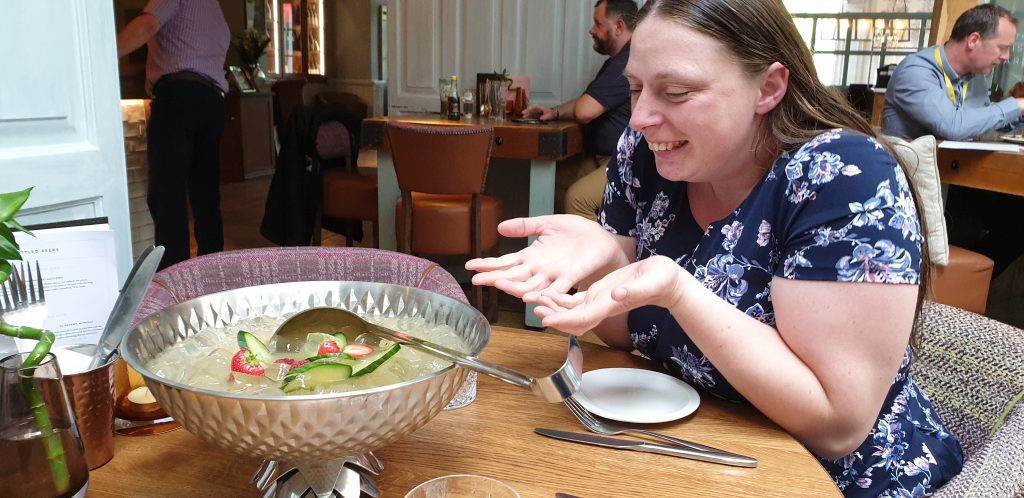
We went out for food and drinks at a local gastropub, and took a brief amble part-way up Arthur’s Seat (but not too far… we had just cycled fifty-something miles), of which our hotel room enjoyed a wonderful view, and went to bed.
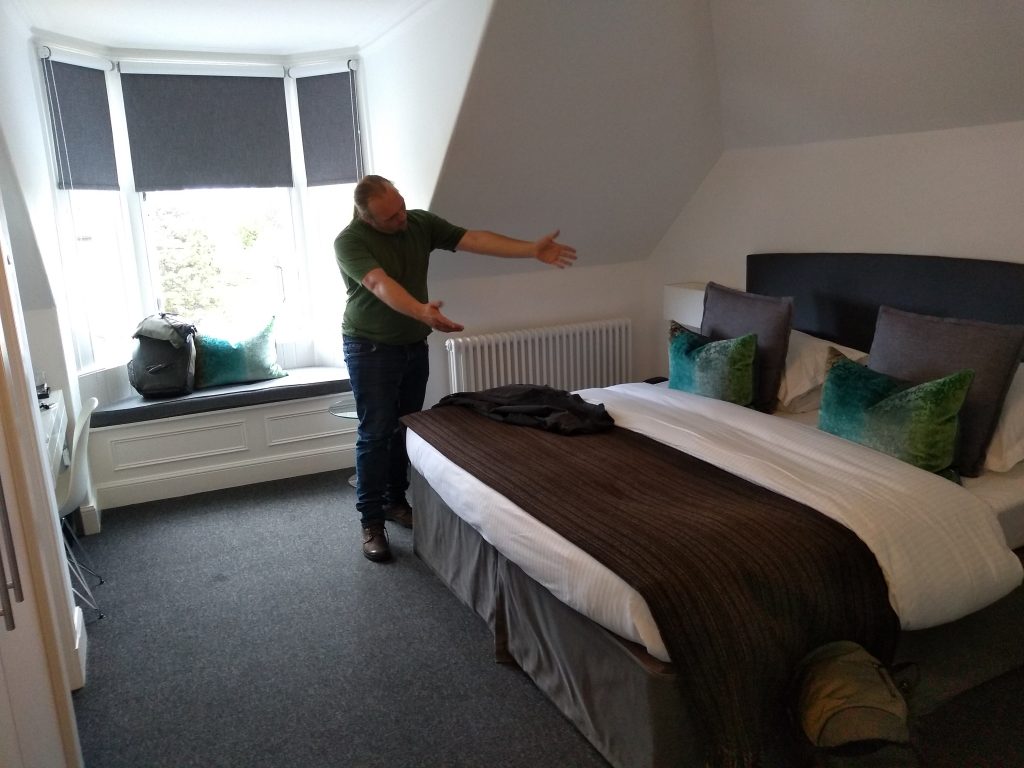
The following morning we cycled out to Craigmillar Castle: Edinburgh’s other castle, and a fantastic (and surprisingly-intact) example of late medieval castle-building.
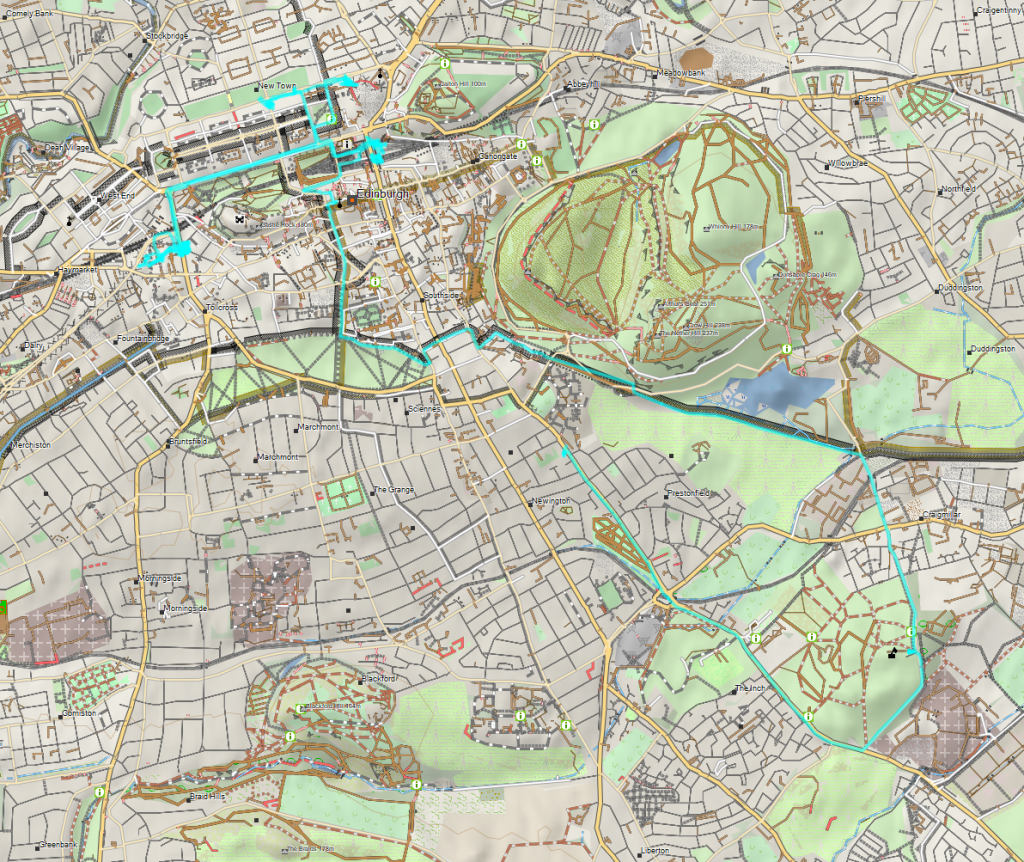
This place is a sprawling warren of chambers and dungeons with a wonderful and complicated history. I feel almost ashamed to not have even known that it existed before now: I’ve been to Edinburgh enough times that I feel like I ought to have visited, and I’m glad that I’ve finally had the chance to discover and explore it.
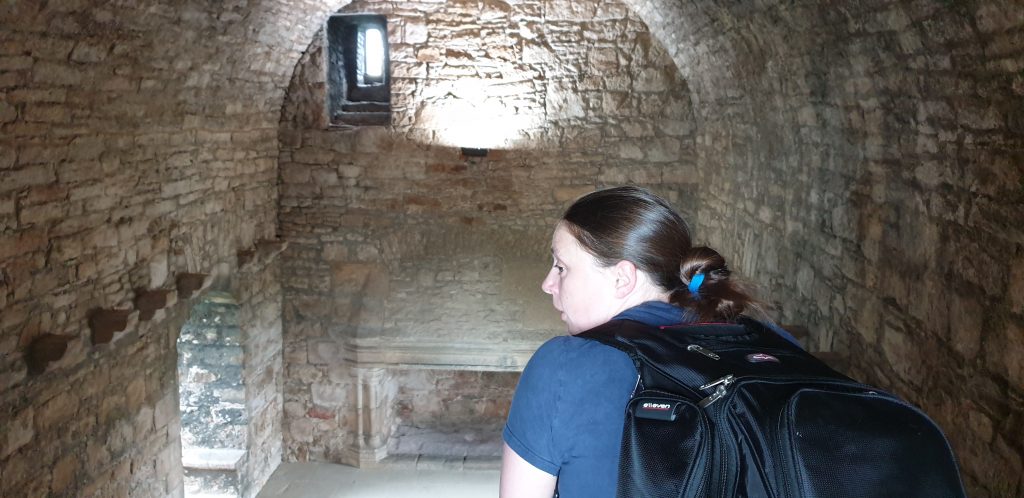
Edinburgh’s a remarkable city: it feels like it gives way swiftly, but not abruptly, to the surrounding countryside, and – thanks to the hills and forests – once you’re outside of suburbia you could easily forget how close you are to Scotland’s capital.

In addition to a wonderful touch with history and a virtual geocache, Craigmillar Castle also provided with a delightful route back to the city centre. “The Innocent Railway” – an 1830s stretch of the Edinburgh and Dalkeith Railway which retained a tradition of horse-drawn carriages long after they’d gone out of fashion elsewhere – once connected Craigmillar to Holyrood Park Road along the edge of what is now Bawsinch and Duddington Nature Reserve, and has long since been converted into a cycleway.
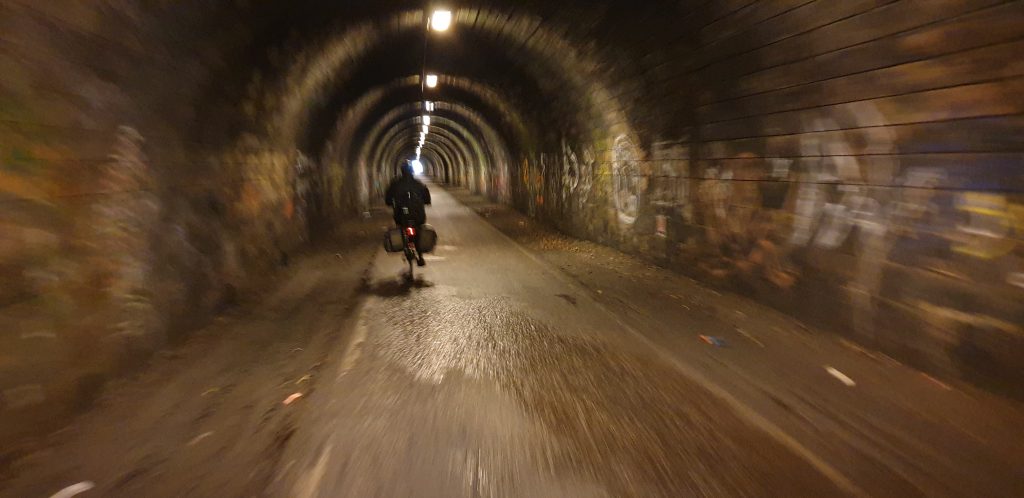
Making the most of our time in the city, we hit up a spa (that Ruth had secretly booked as a surprise for me) in the afternoon followed by an escape room – The Tesla Cube – in the evening. The former involved a relaxing soak, a stress-busting massage, and a chill lounge in a rooftop pool. The latter undid all of the good of this by comprising of us running around frantically barking updates at one another and eventually rocking the week’s highscore for the game. Turns out we make a pretty good pair at escape rooms.

After a light dinner at the excellent vegan cafe Holy Cow (who somehow sell a banana bread that is vegan, gluten-free, and sugar-free: by the time you add no eggs, dairy, flour or sugar, isn’t banana bread just a mashed banana?) and a quick trip to buy some supplies, we rode to Waverley Station to find out if we’d at least be able to get a sleeper train home and hoping for not-another-bus.

We got a train this time, at least, but the journey wasn’t without its (unnecessary) stresses. We were allowed past the check-in gates and to queue to load our bikes into their designated storage space but only after waiting for this to become available (for some reason it wasn’t immediately, even though the door was open and crew were standing there) were we told that our tickets needed to be taken back to the check-in gates (which had now developed a queue of their own) and something done to them before they could be accepted. Then they reprogrammed the train’s digital displays incorrectly, so we boarded coach B but then it turned into coach E once we were inside, leading to confused passengers trying to take one another’s rooms… it later turned back into coach B, which apparently reset the digital locks on everybody’s doors so some passengers who’d already put their luggage into a room now found that they weren’t allowed into that room…
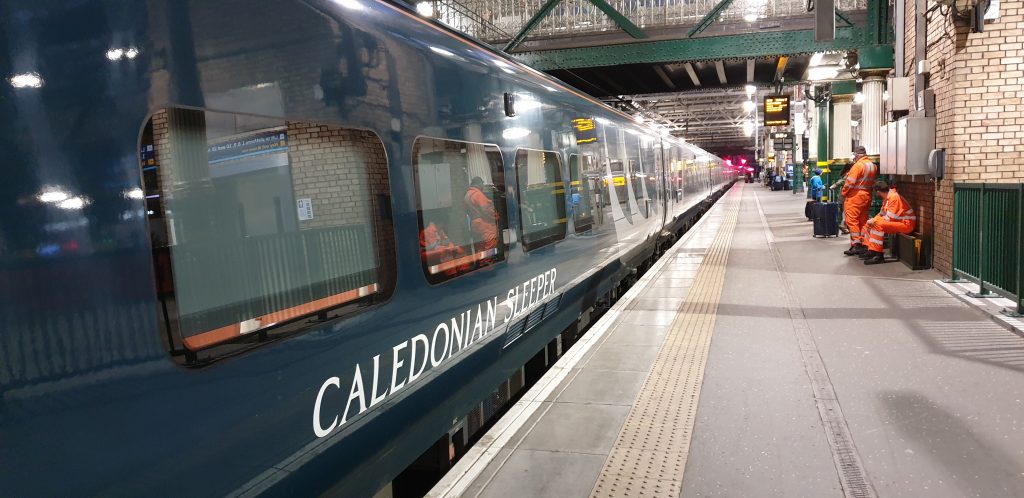
…all of which tied-up the crew and prevented them from dealing with deeper issues like the fact that the room we’d been allocated (a room with twin bunks) wasn’t what we’d paid for (a double room). And so once their seemingly-skeleton crew had solved all of their initial technical problems they still needed to go back and rearrange us and several other customers in a sliding-puzzle-game into one another’s rooms in order to give everybody what they’d actually booked in the first place.
In conclusion: a combination of bad signage, technical troubles, and understaffing made our train journey South only slightly less stressful than our bus journey North had been. I’ve sort-of been put off sleeper trains.
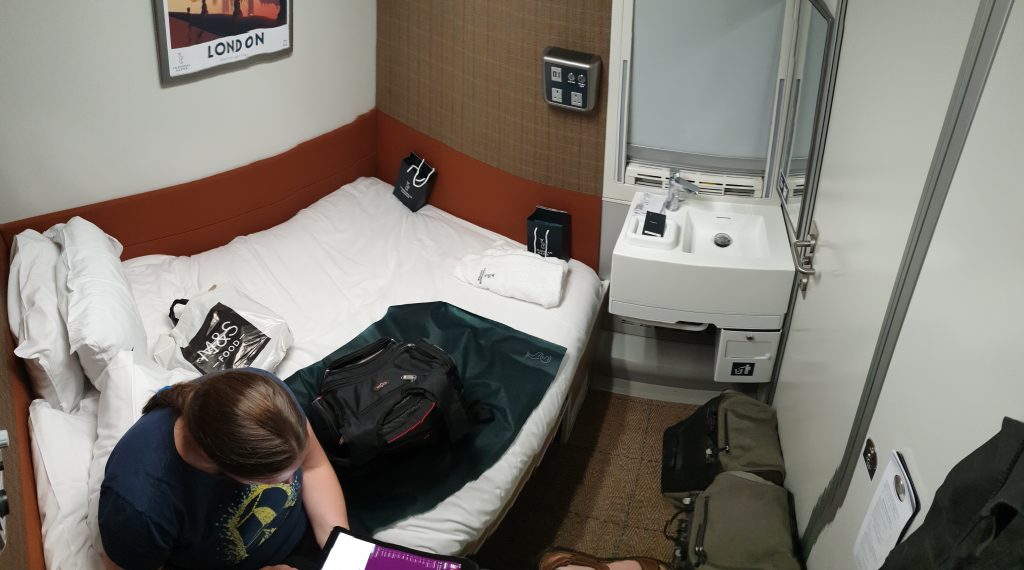
After a reasonable night’s sleep – certainly better than a bus! – we arrived in London, ate some breakfast, took a brief cycle around Regent’s Park, and then found our way to Marylebone to catch a train home.
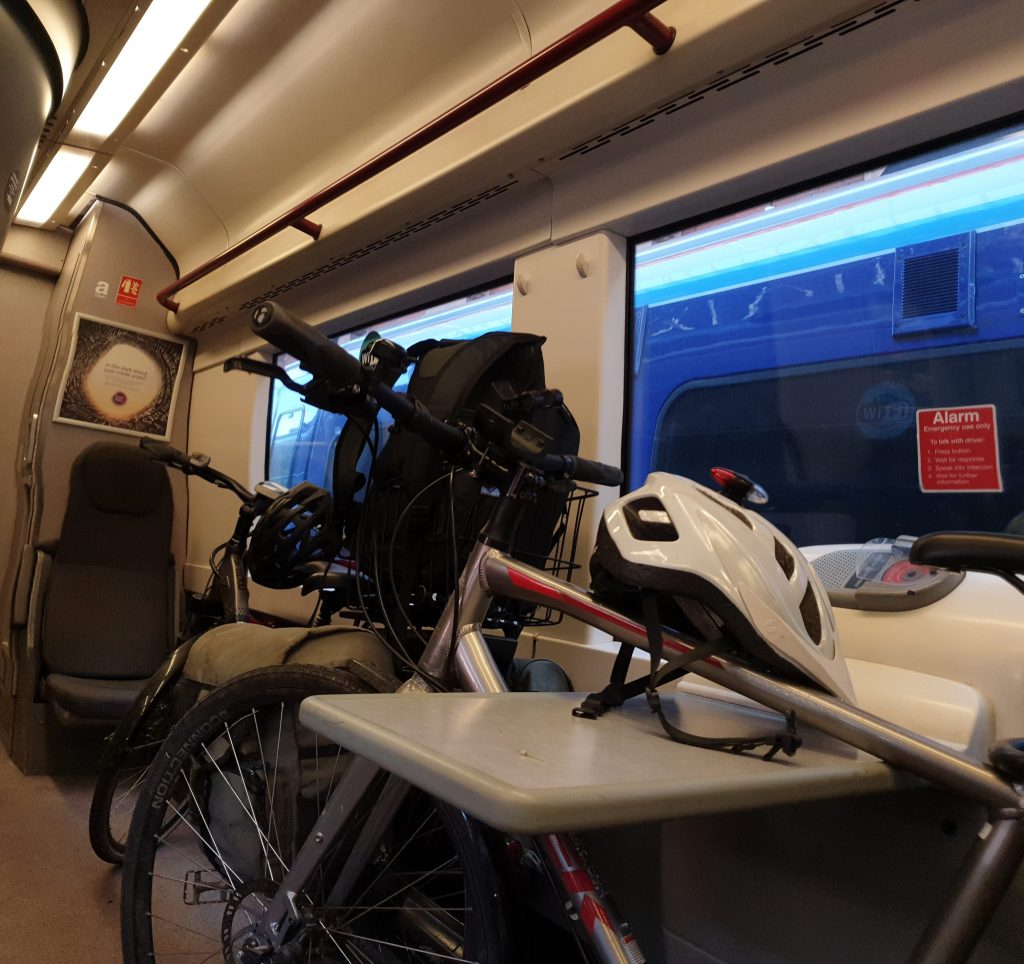
All in all it was a spectacular and highly-memorable adventure, illustrative of the joy of leaving planning to good-luck, the perseverance of wet cyclists, the ingenuity of Victorian engineers, the beauty of the Scottish lowlands, the cycle-friendliness of Glasgow, and – sadly – the sheer incompetence of the operators of sleeper trains.
A++, would celebrate our love this way again.
For the final week of his 52 Reflect series and as a way to see off the year, Robin and I spent the last weekend of the year near Fort William to facilitate a quick ascent of Ben Nevis. My previous expedition to Britain’s highest point was an excuse for some ice climbing but I hadn’t actually come up the “path” route since an aborted expedition in 2009.

Somehow in the intervening years I’ve gotten way out of practice and even more out of shape because our expedition was hard. Partly that was our fault for choosing to climb on one of the shortest days of the year, requiring that we maintain a better-than-par pace throughout to allow us to get up and down before the sun set (which we actually managed with further time in-hand), but mostly it’s the fact that I’ve neglected my climbing: just about the only routine exercise I get these days is cycling, and with changes in my work/life balance I’m now only doing that for about 40 miles in a typical week.

For the longest time my primary mountaineering-buddy was my dad, who was – prior to his death during a hillwalking accident – a bigger climber and hiker than I’ll ever be. Indeed, I’ve been “pushed on” by trying to keep up with my father enough times that fighting to keep up with Robin at the weekend was second nature. If I want to get back to the point where I’m fit enough for ice climbing again I probably need to start by finding the excuse for getting up a hill once in a while more-often than I do, first, too. Perhaps I can lay some of the blame for my being out of practice in the flat, gentle plains of Oxfordshire?
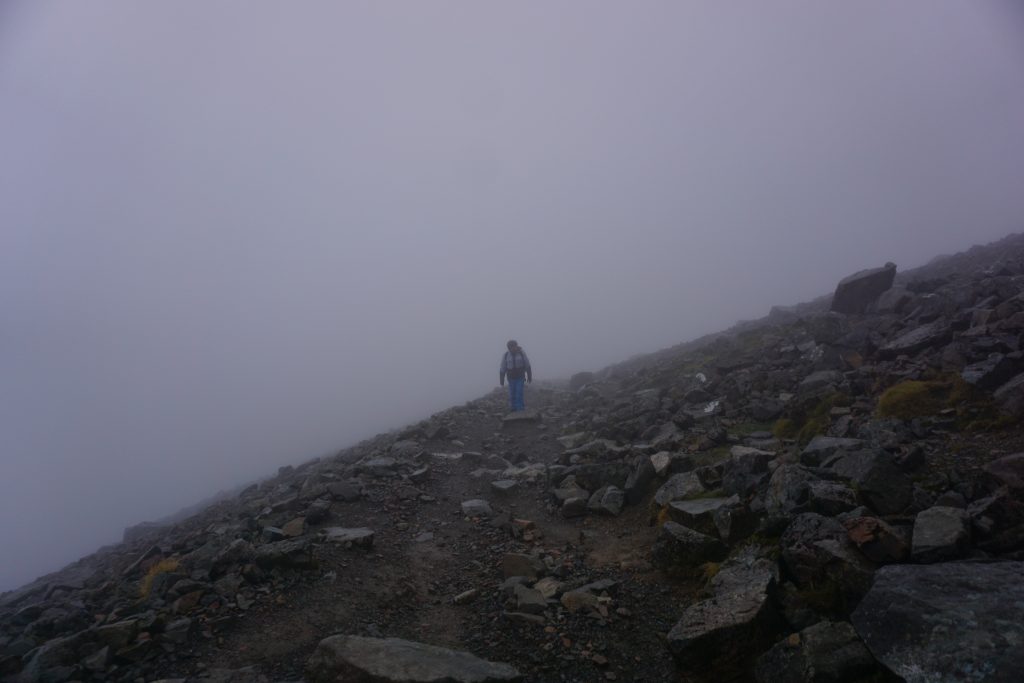
In any case, it was a worthwhile and enjoyable treat to be able to be part of Robin’s final reflection as well as to end the year somewhat-literally “on a high” by seeing off 2018 in the Scottish Highlands. If you’ve not read his blog about his adventures of the last 52 weekends, you should: whether taking a Boris Bike from Brixton to Brighton (within the rental window) or hitching a ride on an aeroplane, he’s provided a year’s worth of fantastic stories accompanied by some great photography.
And now: time for 2019.
This is a repost promoting content originally published elsewhere. See more things Dan's reposted.
Last weekend was an exciting and unusual experience, full of exciting (expected) things interspersed with a handful of exciting (unexpected) things. Let’s go chronologically:
I left work, picked up a rental car (having unfortunately forgotten to take my counterpart driving license to the rental place, I had the choice of either cycling for an hour to collect it or else paying a fiver for them to run a DVLA check, and I opted for the latter on the grounds that an hour of my time (especially if I have to spend it cycling back and forth along the same stretch of road) is worth more to me than a picture of Elizabeth Fry. I drove home, packed a bag, said goodbye to Ruth, JTA, and Annabel, and drove up to Preston.

There, I spent most of Friday playing the new Mario game with my sister Becky, gave a few small performances of magic (did I mention I’m doing magic nowadays? – guess that’ll have to wait for another blog post) at various places around Preston, and went out for a curry with my mother, my sisters Becky and Sarah, and Sarah’s boyfriend Richard. So far, so ordinary, right? Well that’s where things took a turn. Because as Becky, our mother, and I looked at the drinks menu as we waited for Sarah and her boyfriend to turn up… something different happened instead.

Sarah turned up with her husband.
It turns out that they’d gotten married earlier that afternoon. They’d not told anybody in advance – nobody at all – but had simply gone to the registry office (via a jewellers, to rustle up some rings, and a Starbucks, to rustle up some witnesses) and tied the knot. Okay; that’s not strictly true: clearly they had at least three weeks planning on account of the way that marriage banns work in the UK. Any case case, I’ve suddenly got the temptation to write some software that monitors marriage announcements (assuming there are XML feeds, or something) and compares them to your address book to let you know if anybody you know is planning to elope, just to save me from the moment of surprise that caught me out in a curry house on Friday evening.

So it turns out I’ve acquired a brother-in-law. He’s a lovely chap and everything, but man, that was surprising. There’ll doubtless be more about it in Episode 32 of Becky’s “Family Vlog”, so if there was ever an episode that you ought to watch, then it’s this one – with its marriage surprise and (probably) moments of magic – that you ought to keep an eye out for.
Next, I made my way up to Edinburgh to meet up with Matt R and his man-buddies for a stag night to remember. Or, failing that, a stag night to forget in a drunken haze: it’s been a long, long time since I’ve drunk like I did on that particular outing. After warming up with a beer or two in our hotel room, the five of us made our way to the Glenkinchie Distillery, for a wonderful exploration into the world of whiskies.
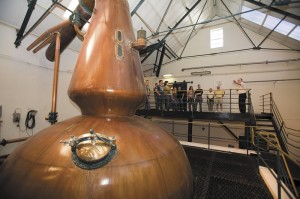
And then, of course, began the real drinking. Four or five whiskies at the distillery bar, followed by another beer back in the hotel room, followed by a couple more beers at bars, followed by another four whiskies at the Whiski Rooms (which I’d first visited while in Edinburgh for the fringe, last year), followed by a beer with dinner… and I was already pretty wiped-out. Another of the ‘stags’ and I – he equally knackered and anticipating a full day of work, in the morning – retired to the hotel room while the remainder took Matt out “in search of a titty bar” (a mission in which, I gather, they were unsuccessful).
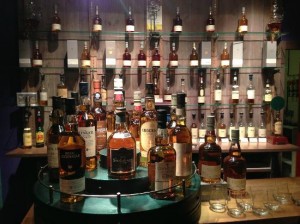
Do you remember being in your early twenties and being able to throw back that kind of level of booze without so much as a shudder? Gosh, it gets harder a decade later. On the other hand, I was sufficiently pickled that I wasn’t for a moment disturbed by the gents I was sharing a room with, who I should re-name “snore-monster”, “fart-monster”, and “gets-up-a-half-dozen-times-during-the-night-to-hug-the-toilet-bowl-monster”. I just passed out and stayed that way until the morning came, when I went in search of a sobering double-helping of fried food to set me right before the long journey back to Oxford.
All in all: hell of a stag night, and a great pre-party in anticipation of next weekend’s pair of weddings… y’know, the ones which I’d stupidly thought would be the only two couples I knew who’d be getting married this fortnight!
After a few years break, I’m once again heading up to Edinburgh for the Fringe Festival. As on previous ocassions, I expect to spend a lot of time enjoying Peter Buckley Hill‘s Free Fringe, which is just about the best thing to happen to the Fringe ever. And this time, I’m going to be better-prepared than ever. I’ve made a map.
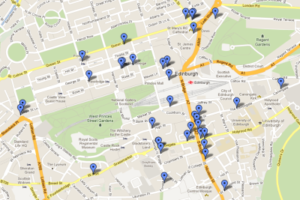
Sharing is caring, so I’ve made the map available to you, too. Click on the picture to see the map. Because it’s in Google Maps it ought to work on your mobile phone. If you’ve got GPS then you can get lost in Edinburgh in high-tech ways you never before thought possible. Click on any given venue for a web address where you can find a list of events that are occurring at that venue.
Or if you’re really nerdy, you can download the KML and go geocaching-for-comedy. Just me? Okay then…
Update: you can now view the map on the frontpage of the Free Fringe website, too.
While JTA was off breaking parts of his body (and showing off his injuries on Reddit) with Ruth on the second part of their honeymoon, the week before last, I too took some time off work in order to have a bit of a holiday. I’d originally hoped to get some cheap domestic skiing in, but the weather forecast showed that Scotland was going to consist of exactly two weather conditions, depending on where you were:
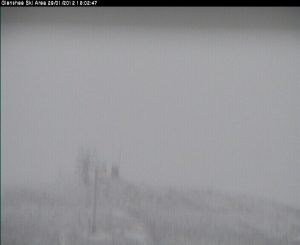
This kind-of put a dampener on my plans to get some snowsports done, but I’d already taken the time off work so I re-arranged my plans into a “make it up as you go along” tour of the highlands and lowlands of Scotland.
Highlights of my little tour included:
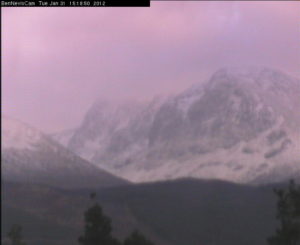
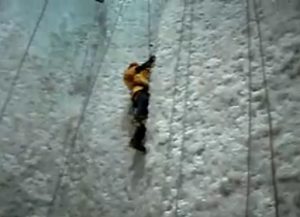
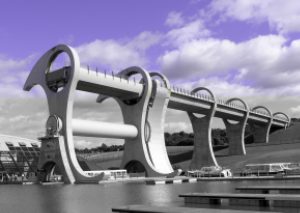
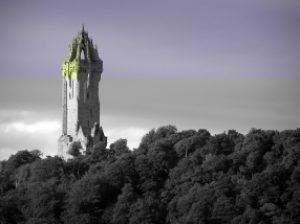
All in all, a delightful little tour, particularly impressive considering that it was launched into with the minimum possible amount of planning.
This is a repost promoting content originally published elsewhere. See more things Dan's reposted.
This repost was published in hindsight, on 12 March 2019.
Ruth wrote:
Since I last posted, I’ve been fairly busy, one way and another. First, Dan and I travelled up to Preston where I was forced to allow that it isn’t a complete pit after all because it does have a couple of nice bits (viz, a pretty park by the river and a nice museum/library with a ball on a really long bit of string in the lobby).
We also visited Blackpool, which was a new experience for me. Incidentally, the entertainment value of eating giant eclairs and then riding on a waltzer is limited. I kicked Dan’s arse at crazy golf, on a really nice course with astro-turf and little streams.
Later, we travelled up to Scotland with some crazed, drunken bus company employees (they were an ok bunch apart from their habit of getting up at 5am) to canoe the Caledonian canal. I managed the 18 mile first day, got out of our boat and found that my RSI had flared up and I couldn’t move my arms at all. Dan sympathetically fell about with laughter, but on the third day (Fort Augustus to Drumnadrochit) the winds on Loch Ness were so bad that he and the other canoeists were forced off the water so we both finished up walking the Great Glen Way to Inverness.
On the way back down, the planets were aligned correctly (or something) so we were able to do the surprise thing that Dan had been planning for ages as my graduation treat. We got up at 5.30 and drove out to a deserted farm shop on the outskirts of Preston, where we sat in a car park for 10 minutes or so before a battered landrover emblazoned with “Pendle Balloon Company” arrived towing a large basket on a trailer. I was surprised.
Ballooning was amazing. First, we got to help put the balloon up (which was really cool). The inside is full of wires and cables which are used to control it in various ways. We went up to 5500 feet before coming back down so we could get a better view of the countryside. It was cold at that height but there was barely a breath of wind for reasons which I am sure you can all figure out by yourselves (I felt colder when we eventually touched down and could feel the breeze again). The views were stunning, the gentleness of the flight was quite something, and I had a great time. When it was over, we drank champagne with the pilot and other passengers (which is apparently a ballooning tradition, although I don’t know whether the plastic beakers are traditional or not).
It was a good trip. Knackering, and full of unexpected events, but highly enjoyable. Now I’m settling in for a summer of alternating basking in the sunshine with working like buggery on voluntary projects. All I need is a part time job so I can carry on eating and paying the rent, and I’m set.